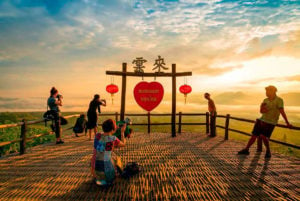Experience Chiang Rai Loop: 31 Unforgettable Spots (2025)
Chiang Rai, a captivating city in the heart of Northern Thailand, beckons travelers with its enthralling blend of cultural heritage, stunning natural beauty, and diverse experiences. From the mesmerizing White Temple (Wat Rong Khun) to the immersive Black House (Baan Dam), Chiang Rai’s unique attractions showcase its artistic prowess and deep-rooted history. Explore verdant tea plantations, vibrant hill tribe villages, and the majestic Golden Triangle, where the borders of Thailand, Laos, and Myanmar converge. With its intriguing night markets, delectable local cuisine, and a multitude of outdoor adventures, Chiang Rai offers an enchanting and unforgettable experience for those seeking to uncover the hidden gems of Northern Thailand.
Chiang Rai Loop starts in Chiang Mai and circles some of Thailand’s highest peaks, covering about 720 km around two mountain tops – Doi Tung and Doi Angkhang. The best way to travel through the Chiang Rai Loop is by motorcycle or car. But since this route has many steep ascents and descents, it is not recommended for novice drivers with poor driving skills. If you do not have sufficient driving experience, book a private tour or hire a cab.
If you use a motorbike with an automatic transmission, be sure to read the article on why the brakes fail even for experienced riders when misused on mountain slopes.
If you prefer to rent a car, including the option to return the rental car to a rental location in another city, we recommend that you compare car rental rates in Chiang Rai. Prices may differ by half or more.
Location: Northern Thailand
Chiang Rai Province area: 11,503 sq.km [R]
Population density: 111,9/sq.km
Chiang Rai Province Population (2021): 1,287,615 people; 464,101 households
Chiang Rai City Population: 223,725 people; 103,435 households
Main sources of income: agriculture, forestry, and fishery
Cultivated crops (in descending order of annual harvest): rice, cassava, corn, longan, rubber tree, pineapples, potatoes, palm oil, tangerines, onions, coffee, lychees, rambutan, garlic, soybeans, mangosteen
Average annual income per person: 80,477THB [R]
Number of religious places: 309 Buddhist monasteries, 702 Buddhist temples, 80 Buddhist study centers, 141 Catholic churches, 133 Protestant churches, 7 registered mosques [R]
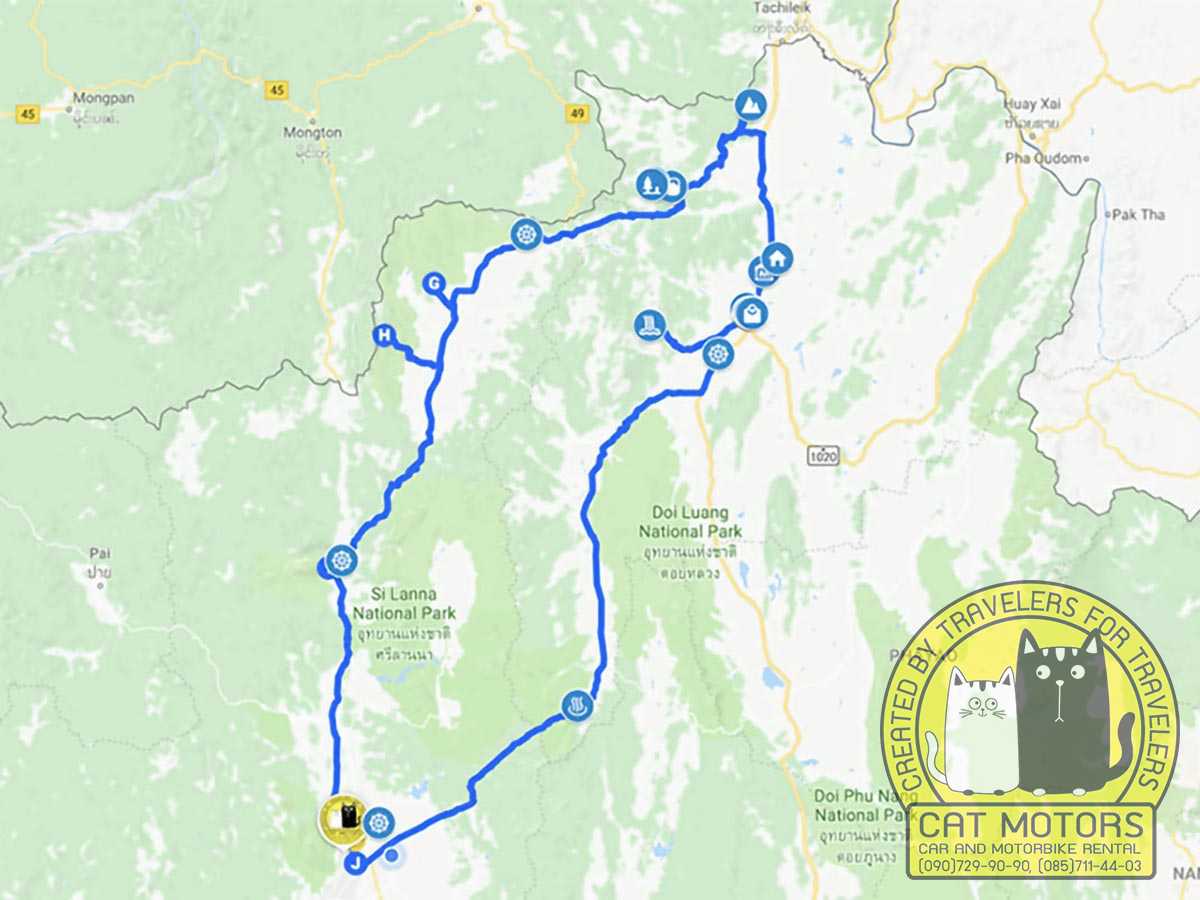
Day 1: Chiang Mai – Chiang Rai
Direct route – 186km
Scenic route – 232km
Most of the routes tourists take in northern Thailand start in Chiang Mai because there is an international airport here, and an international flight is the fastest way to get to the country’s north. The Chiang Rai Loop is no exception. Today we will tell you about what places you can visit in Chiang Rai and what you can see on the way here.
Covering Chiang Rai’s White Temple, Golden Triangle, and mountainous landscapes, the Chiang Rai Loop is a dream road trip for adventurers. Since buses only connect major towns, renting a car in Chiang Mai is the best way to explore remote attractions like Doi Mae Salong and Phu Chi Fa at your own pace. Start planning here: Your Car Rental Guide.
Things to do on the way to Chiang Rai
Mae Kachan Hot Springs
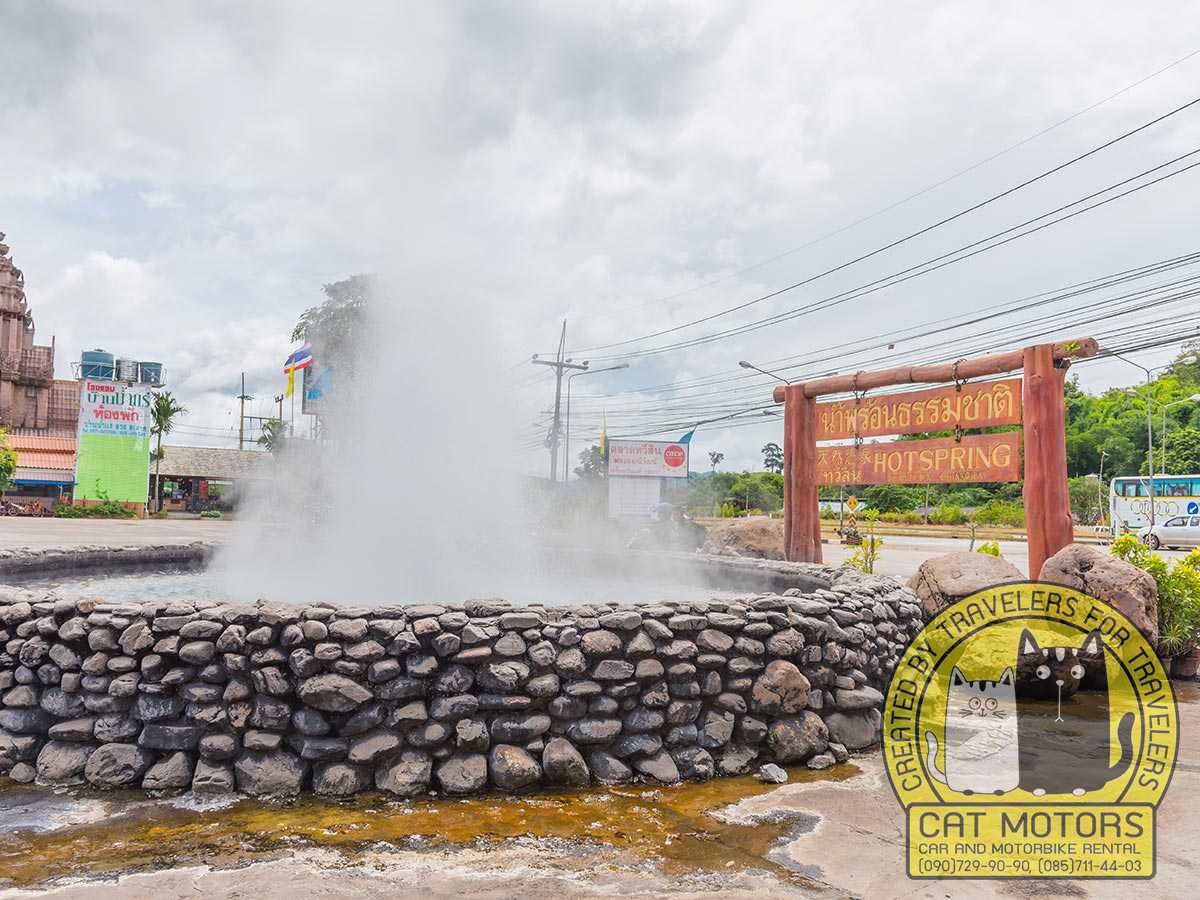
As you chart your journey through Northern Thailand, a delightful detour beckons – the Mae Kachan Hot Springs. Located in the scenic route between Chiang Rai and Chiang Mai, near the town of Wiang Pa Pao, these natural springs offer a unique blend of relaxation and local charm.
Envision a serene setting where geothermal waters emerge from the earth, creating steaming pools that promise a therapeutic escape. The Mae Kachan Hot Springs are famed for their mineral-rich waters, believed by locals to possess healing properties. It’s a perfect spot to unwind after a day of exploring, with the option to dip your feet into the warm waters or indulge in a full-body soak in the public pools.
But Mae Kachan is more than just a place to relax. It’s a glimpse into local Thai life. The area around the springs features small shops and stalls, where you can find an array of local products from handmade crafts to herbal remedies. Don’t miss the chance to try a unique local experience – boiling eggs in the hot spring waters, a fun and tasty way to engage with the local traditions.
Mae Kachan Hot Springs offer an excellent opportunity to rejuvenate. Remember to bring a towel and a change of clothes if you plan to take a dip. The hot springs are easily accessible by road and provide a welcome break, especially if you’re on a road trip between Chiang Mai and Chiang Rai. Open daily, it’s a budget-friendly experience, often more frequented by locals than tourists, adding to its authentic charm.
Whether it’s for relaxation, a touch of health, or just to experience a slice of Thai culture, Mae Kachan Hot Springs is a delightful stop on your Northern Thailand adventure.
ATTENTION! We are aware of dozens of cases in this place when scammers fooled tourists by selling them pinchbecks, saying that it was real gold. The price was the same as if they were buying real gold…
Khun Korn Waterfall
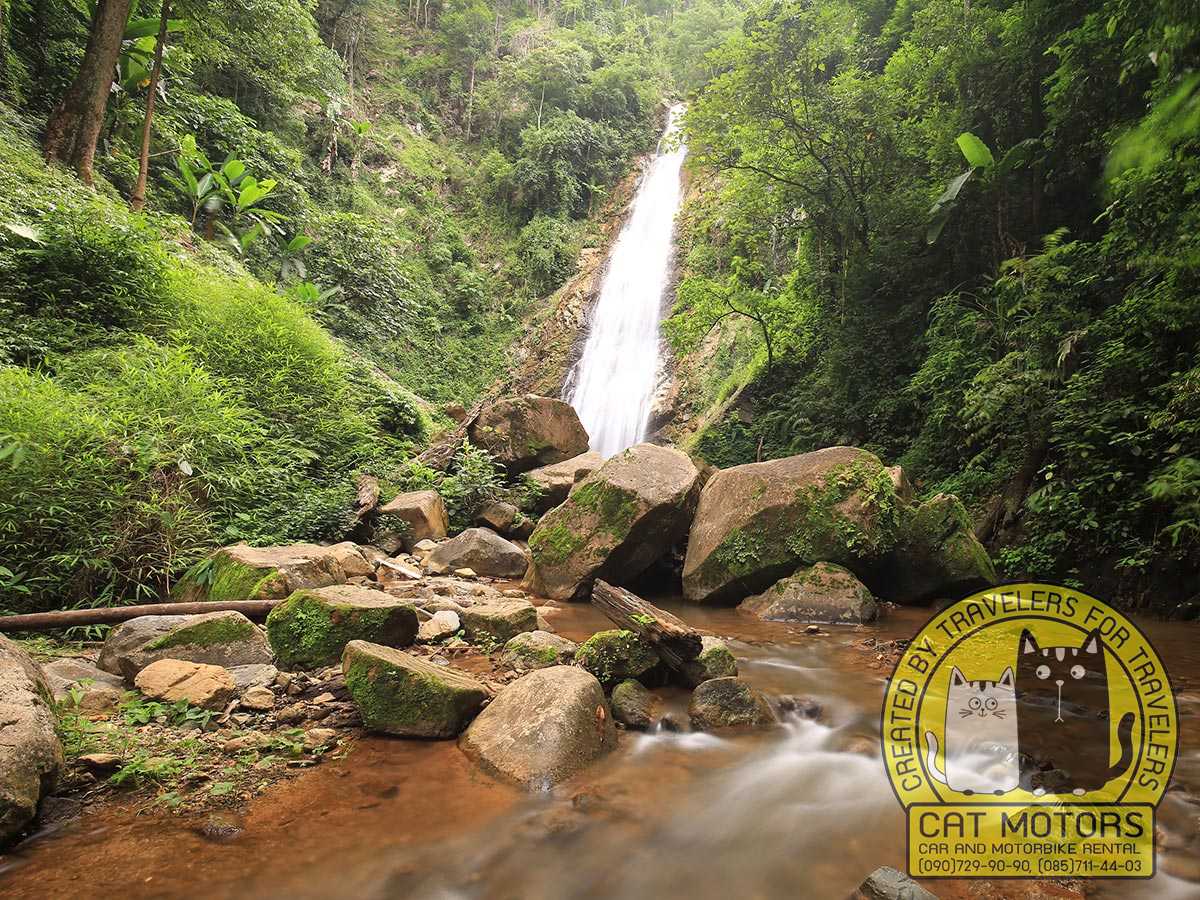
Khun Korn Falls is one of the most beautiful waterfalls in Northern Thailand! The waterfall is close to the city (30 km) and is one of the highest in the area, its height is about 70 meters. We highly recommend a visit to this beauty! The waterfall also comes with a 1.5 km trail from the carpark leading up to it so we recommend you wear a good pair of trekking or walking shoes. While the waterfall does get a couple of tourists, it is never too crowded and during the summer months you will see a lot of locals taking a dip in the cool waters of the waterfall.
Don’t be lazy to reach the waterfall on foot, because you still have two or three days of tedious motorcycle ride on the Chiang Rai loop.
Things to do in Chiang Rai:
Wat Phra Singh
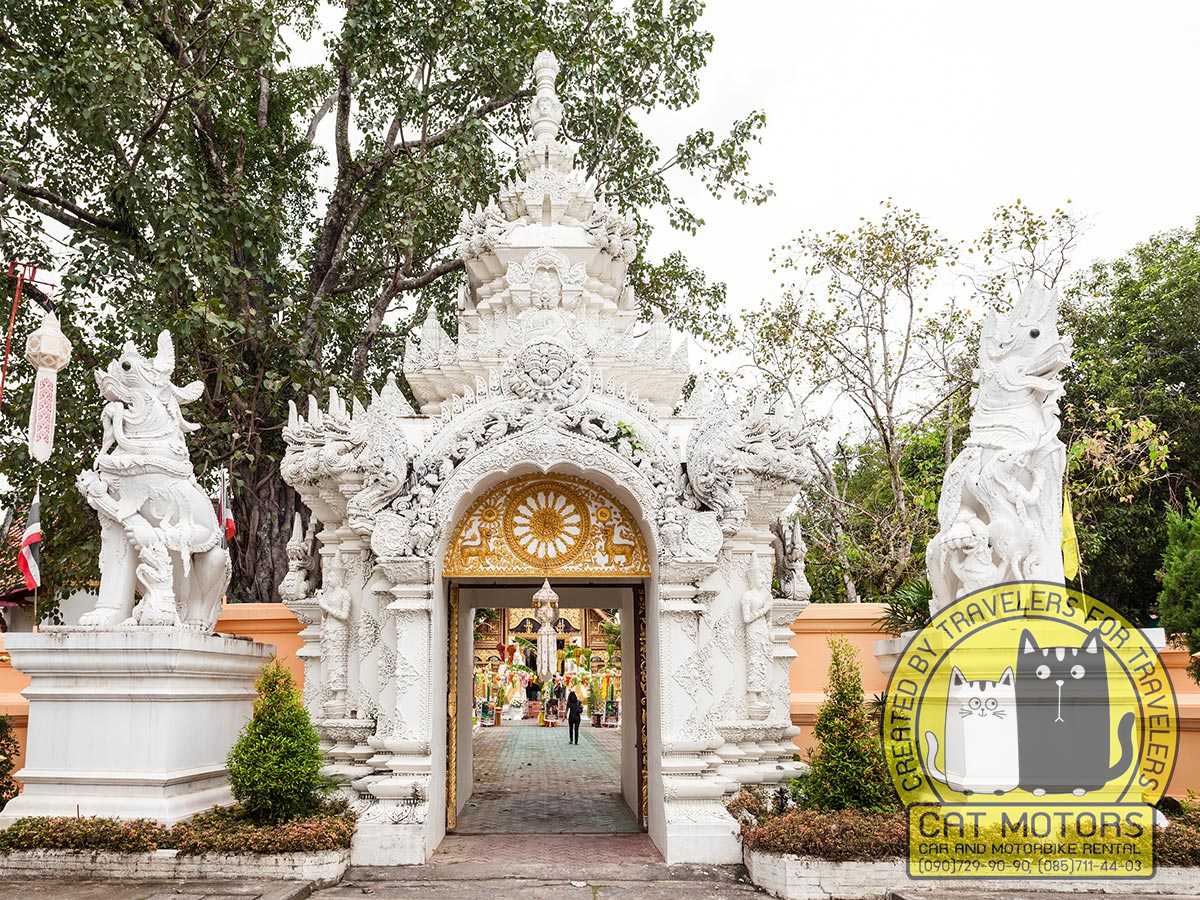
The Wat Phra Singh Temple was originally built in Chiang Rai that also housed a very auspicious statue of the Buddha that pilgrims from all over the world would come to see – but over the years, the statue has been relocated to the Wat Phra Singh in Chiang Mai. The temple built in the old Lanna style, which includes many columns with intricate carvings of golden teak wood.
If you are interested in religious sites, then read our Chiang Rai Temples travel guide.
Wat Phra Kaew
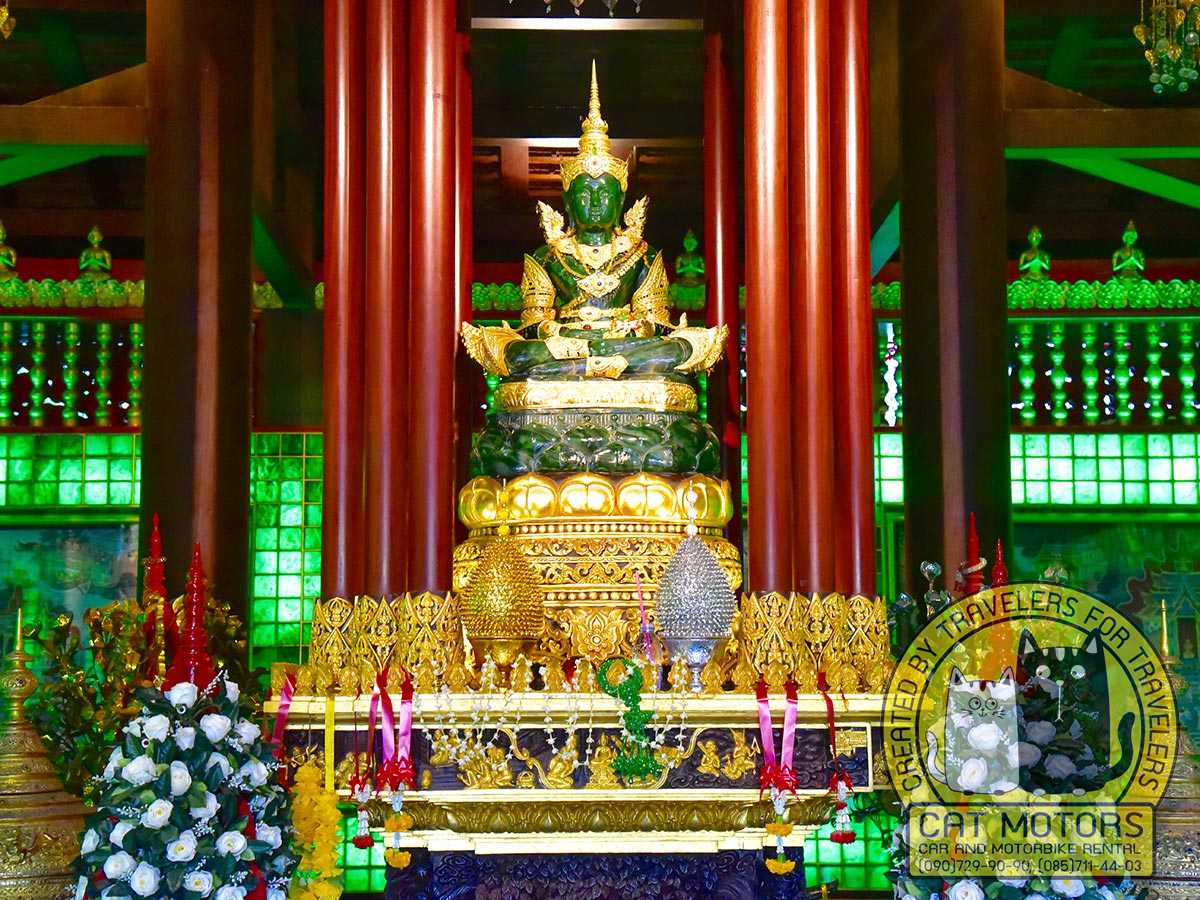
The Wat Phra Kaew is officially called the Wat Phra Si Rattana Satsadaram (which translates to The Temple of the Emerald Buddha in English). Being one of Thailand’s most sacred and revered Temples amongst Buddhists for once housing the original statue of Buddha,The Temple of the Emerald Buddha now only houses a replica, made of green jade as the original was relocated to Bangkok.
Wat Phra That Doi Chom Thong
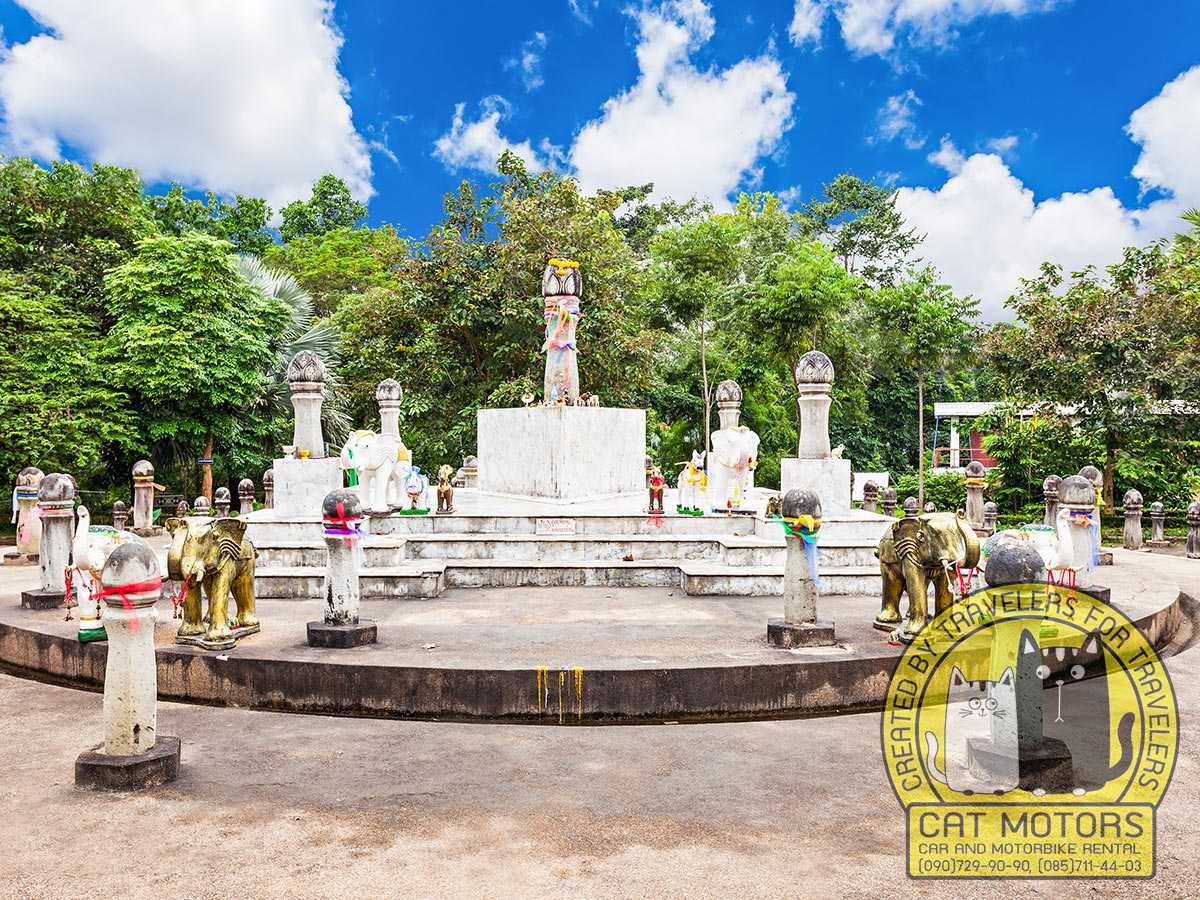
The Wat Phra That Doi Chom Thong is an ancient monastery in Chiang Rai built atop a mountain that offers a nice vantage view of Chiang Rai. The Temple holds quite a uniqueness to it for it’s unusual Buddhist articles and the pillars that are arranged in accordance with Lanna tradition, representing the relationship between Buddhism and Hinduism.
The temple has been in use for over a 1,000 years now and was a local spirit house long before Buddhism arrived in the area.
Wat Ming Mueang
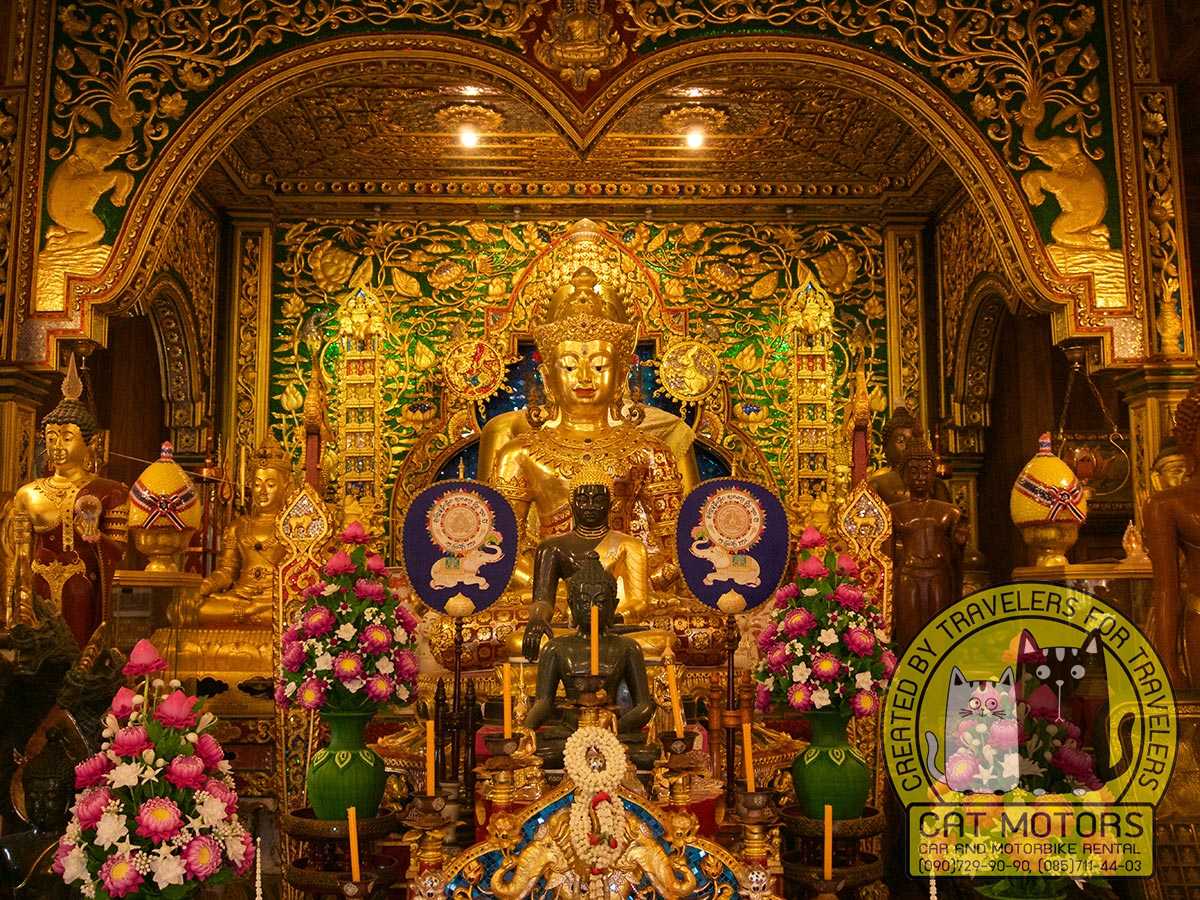
Wat Ming Mueang is a 700 year old temple in Chiang Rai known for its intricate architecture and beautifully painted ceiling. Back in the day, The Temple was of utmost importance in the town because of its royal patronage.
Inside the temple you will find a lot of artifacts and collectibles that are of historical importance that prove connections between multiple diverse cultures, most of them being put on display for tourists. The building is erected in typical Thai style architecture and at one point was known as Tai Yai people’s Temple.
Gold Clock Tower (21:00)
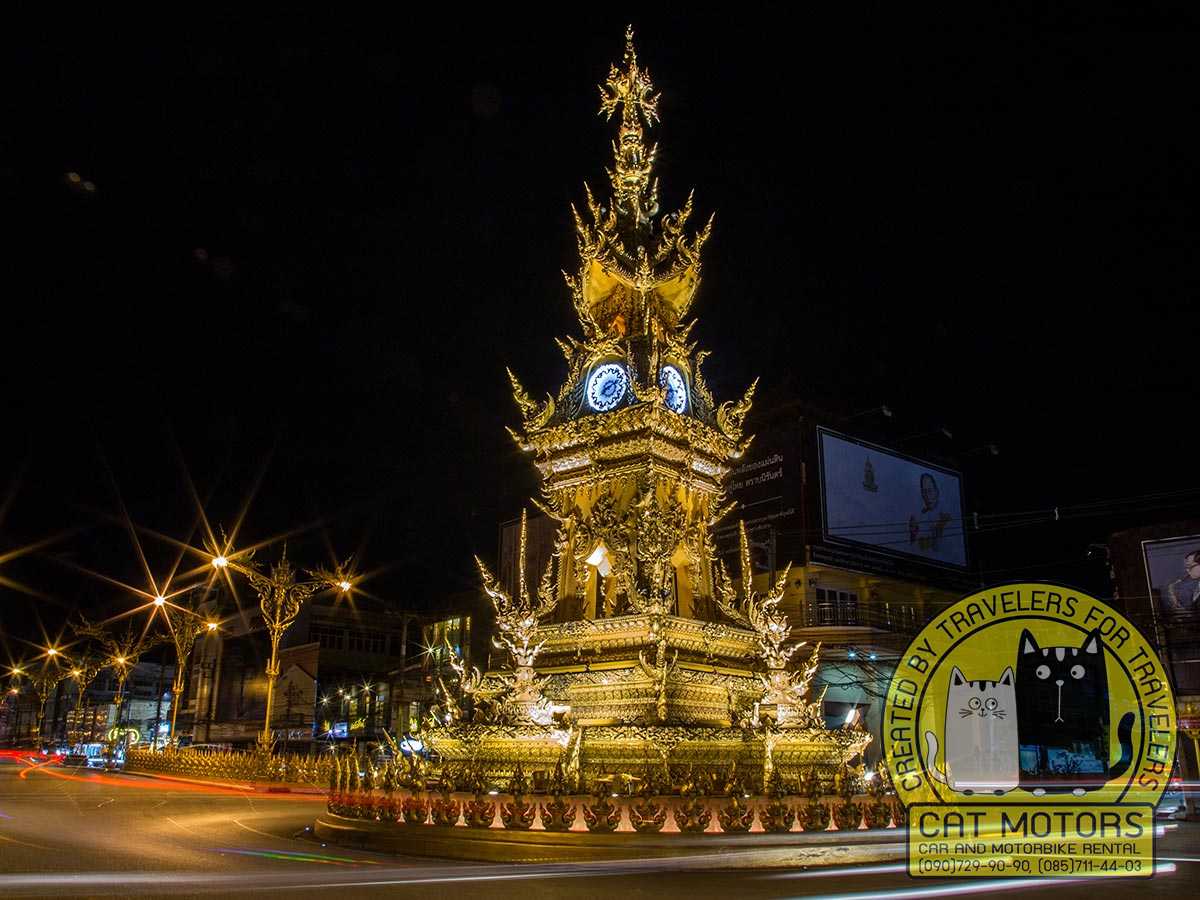
The Gold Clock Tower is a work of art unveiled in 2008 by a Thai artist known as Chalermchai Kositpipat in honor of His Majesty, King Rama IX. The Clock Tower serves as a traffic roundabout. While being distinctive enough during the day, the structure and setting take on a new quality when lit up in the evening – becoming quite the attraction among tourists!
Every night at 7pm, 8pm and 9pm, the tower turns into a masterpiece with light and sound display – it is definitely a remarkable thing to watch! Meed to look while traveling on Chiang Rai Loop.
Chiag Rai Night Bazaar
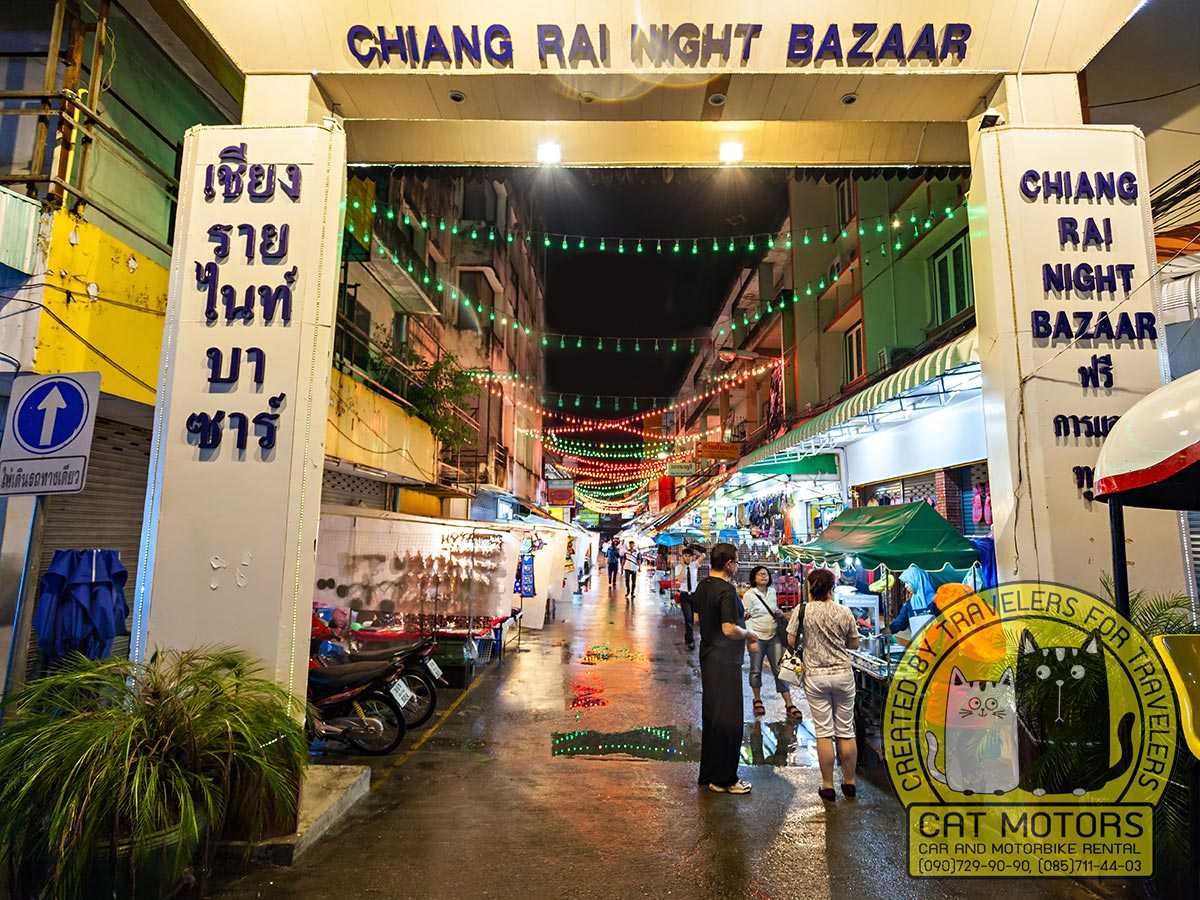
Chiang Rai is famous for its night market, which starts around five o’clock every evening. It is an ideal place to buy souvenirs, handicrafts, handicrafts, etc. Another great thing to try out at the night markets is the food, where you will find some of the best Thai street food on display which does not disappoint!
The only place on the Chiang Rai Loop where you will find a lot of souvenirs and a lot of tasty, varied and authentic Thai food. Eat well and use this opportunity to buy great gifts for your friends and family.
Chiang Rai Night Bazaar Location
In the heart of Chiang Rai, the Night Bazaar is a vibrant hub of culture and commerce, located at the intersection of Thanalai and Prasopsuk Roads. As evening falls, the market bursts into life, offering a rich array of Thai crafts, tantalizing street food, and live cultural performances. It’s a place where the charm of Northern Thailand is on full display, from traditional music to the friendly bartering over unique souvenirs. Opening around 6 PM and bustling until about 11 PM, the Night Bazaar is a must-visit for any traveler seeking an authentic Thai experience.
Google Map – https://goo.gl/maps/oRn8kqmvEwainTBM9
Singha Park
Singha Park deserves special attention, which is not only a farm-like park but also a venue for concerts, festivals, and other festive events in Chiang Rai. Charity marathons are regularly held here, and the place is home of Hot Air Balloon Festivals.
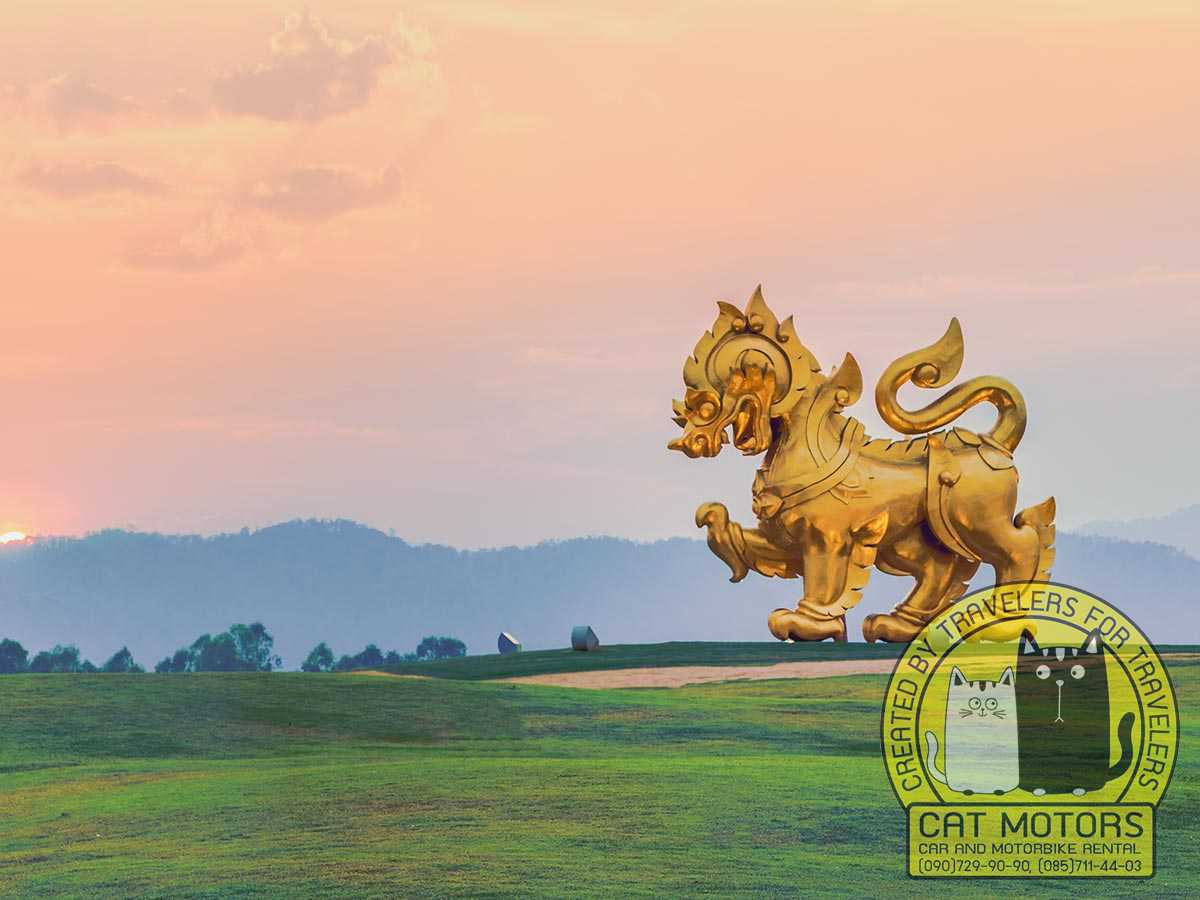
Also, you’ll find rock climbing and cycling, a zoo with giraffes and zebras, tea plantations and zip-lining, camping, and a restaurant with breathtaking views from the veranda during lunch and dinner.
For a detailed description of this place, see the travel guide about Singha Park. A leisurely visit to this place will take at least half a day, so allow extra time for it. That is, you can make changes to our travel guide, and you can visit Singha Park on the second day and go to Mae Salong on the third day.
If you stick in Chiang Rai for a day to visit Singha Park, check out our travel guide to the Golden Triangle, located in Chiang Rai province on the border of Thailand, Laos, and Myanmar, separated by the Mekong River. The drive there and back takes only three hours. You can visit both sites in one day.
Day 2: Chiang Rai – Mae Salong
If you stay here for one more night, then you will have time to visit the magnificent Phu Chi Fa mountain, which is located on the Thai-Lao border, and with which breathtaking views of the surrounding area open up.
There are two routes to get to Mae Salong – the first one goes straight through and is about 60-70km long, the other route is more scenic route but more than double the distance in terms of kilometers. The best way to get to here is by motorcycle.
Direct route – 60km
Scenic route – 170km
Thing to do on the road to Mae Salong:
Blue Temple Wat Rong Suea Ten (open 7:00)
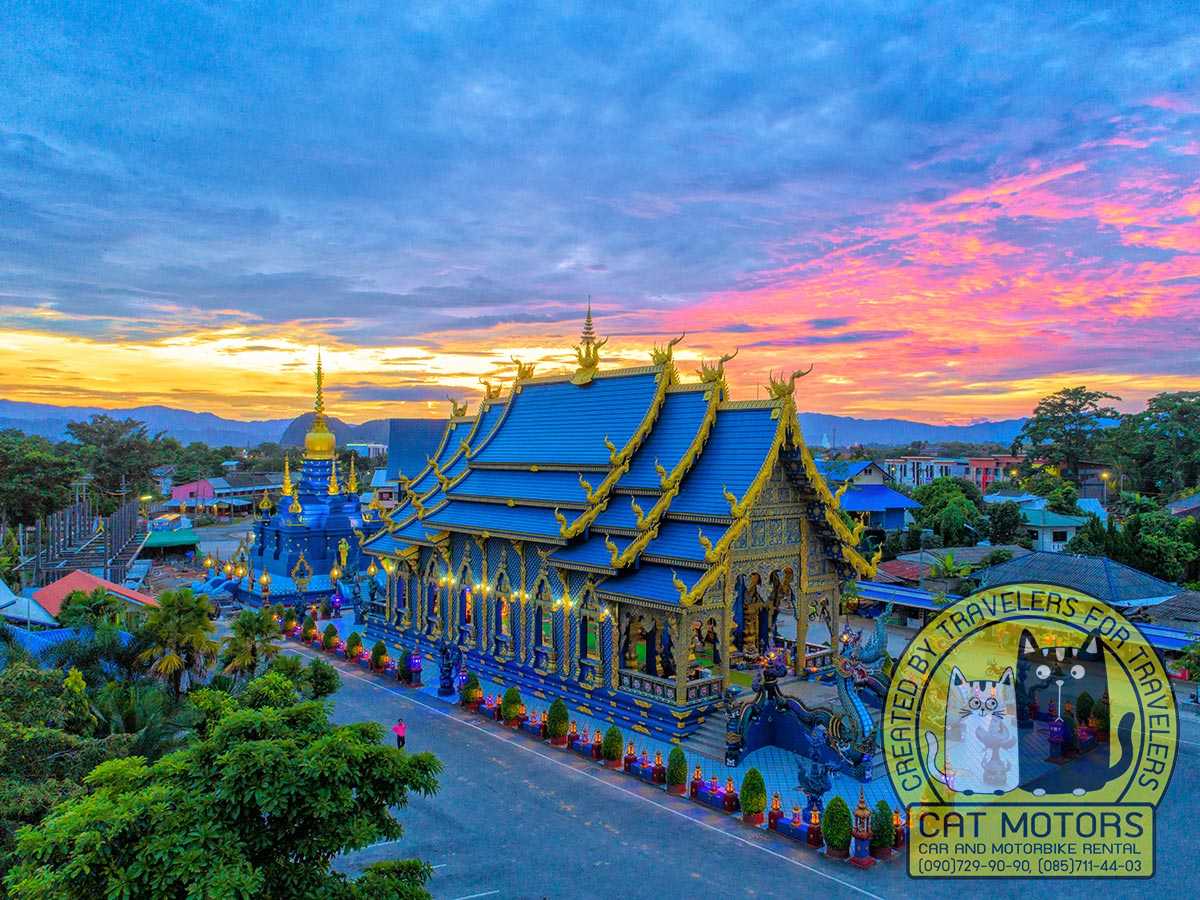
The Blue Temple is widely regarded as the most underrated temple in Thailand. It was opened in 2016, after 11 years of construction, and has yet to become popular with the crowds of package tourists. The architect of the temple is Salah Nok, a disciple of the world-renowned artist Chalermchai Kositpipat who built the White Temple. Read more about the place on our website here – Blue Temple Chiang Rai.
White Temple Wat Rong Khun (open 8:00)

Wat Rong Khun is probably the most interesting Buddhist temple that you will visit in all of Northern Thailand, that is because Wat Rong Khun is a large art exhibit that is also in the shape of a Buddhist temple. The original Wat Rong Khun was bought by local Thai artist Chalermchai Kositpipat, who also designed the Golden Clock Tower. He spent a lot of his own money in renovating Wat Rong Khun to make it a tourist attraction and intends to use the space around Wat Rong Khun for tourists to learn about the teaching of Buddhism.
This place is more popularly known among tourists as the White Temple in Chiang Rai.
Open from 8am, but be sure to arrive early, before peak time! A must-see if you are traveling in Chiang Rai.
Black Temple or Black House (open 9:00)
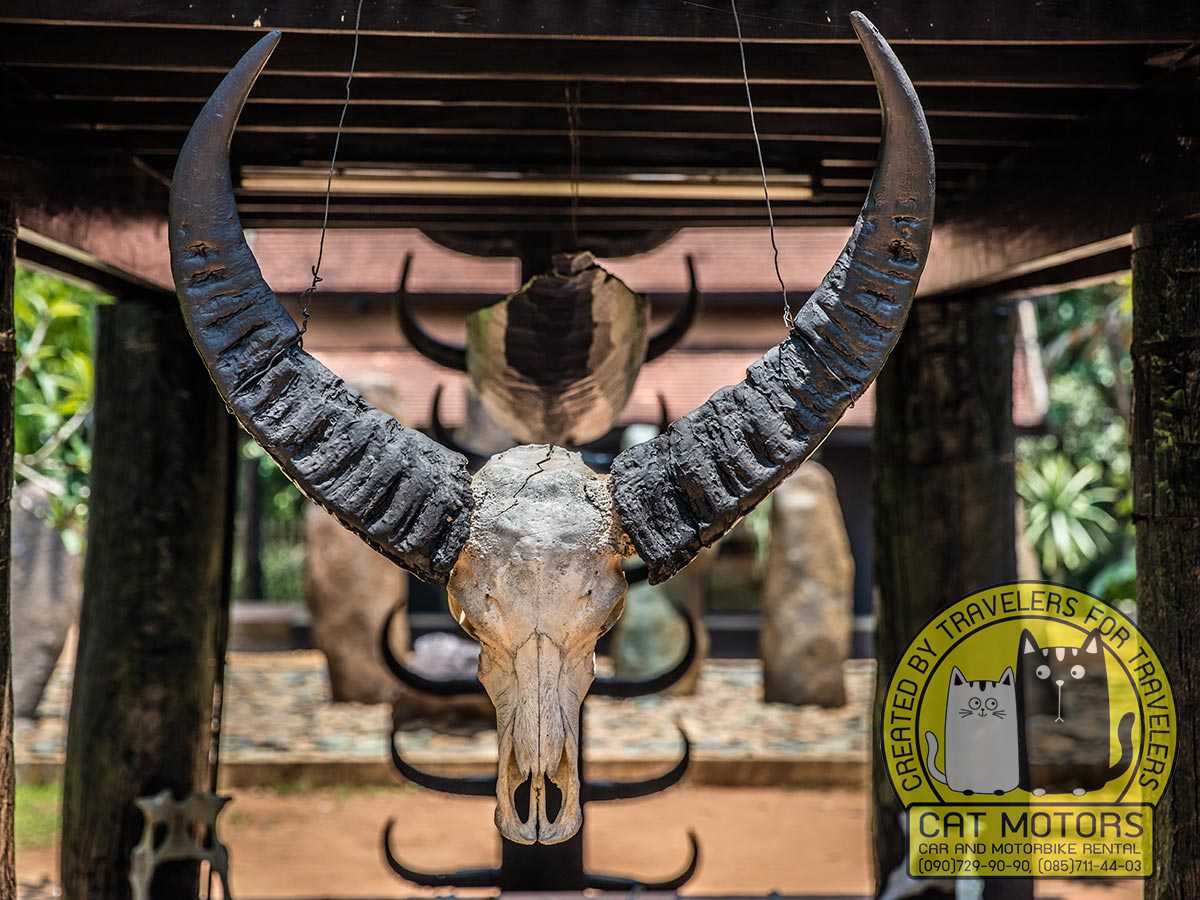
Most commonly known as The Black Temple or The Black House, Baan Dam Museum is a temple styled art gallery that would probably impress even the most vetted temple hopper. Baan Dam Museum features work by Thawan Duchanee and other contemporary Thai artists that includes a collection of wood buildings, painted black with each of them holding a different display of uniqueness tied to the Black House theme.
In saying that, each exhibit is made from the remains of a variety of dead animals including moose antlers, water buffalo skulls, to snake skins and even blow fish hanging from the ceiling – almost everything from the Black House is made from the remains. Although, there is no sense of being in an animal cemetery at all as it has been laid out quite artistically and is unlike anything you’ve seen before!
The Black House is home to a lot of Thawan Duchanees life work along with a lot of artist’s taxidermy too.
Perhaps this could be the most unusual place on the Chiang Rai Loop?!
Union of Hill Tribe villages and the Karen Long Necks
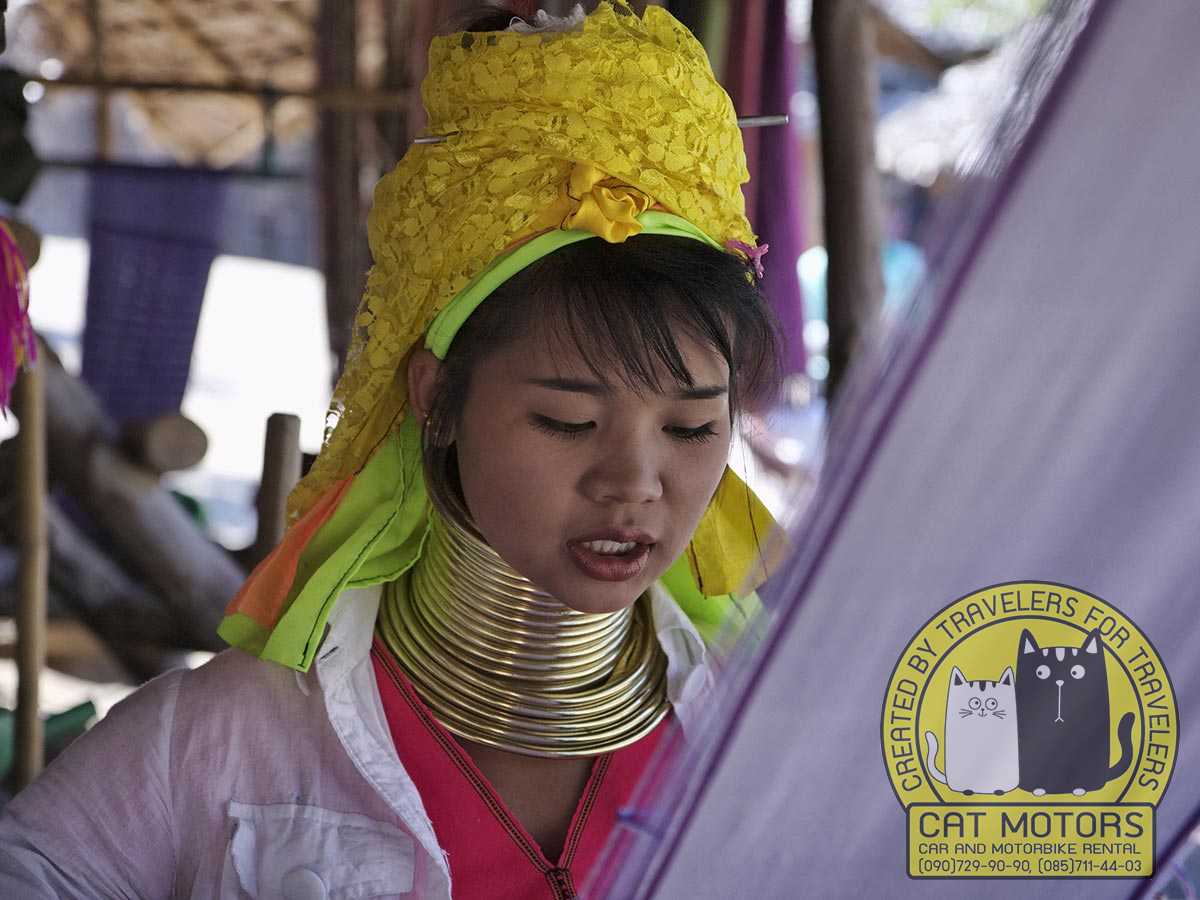
Northern Thailand borders Burma and is a very mountainous region home to a large number of tribes and their people. For the tribes that are willing, the Thai Tourism Department has created accessible villages for them to inhabit which has made them open for tourists.
The small village known as Union of Hill Tribe Villages is inhabited by the more commonly known tribe, Karen Long Necks, where tourists from all over the globe can come to understand their lives, culture, and practices, whilst also being able to take home a piece of Thailand’s tribal heritage.
Doi Tung
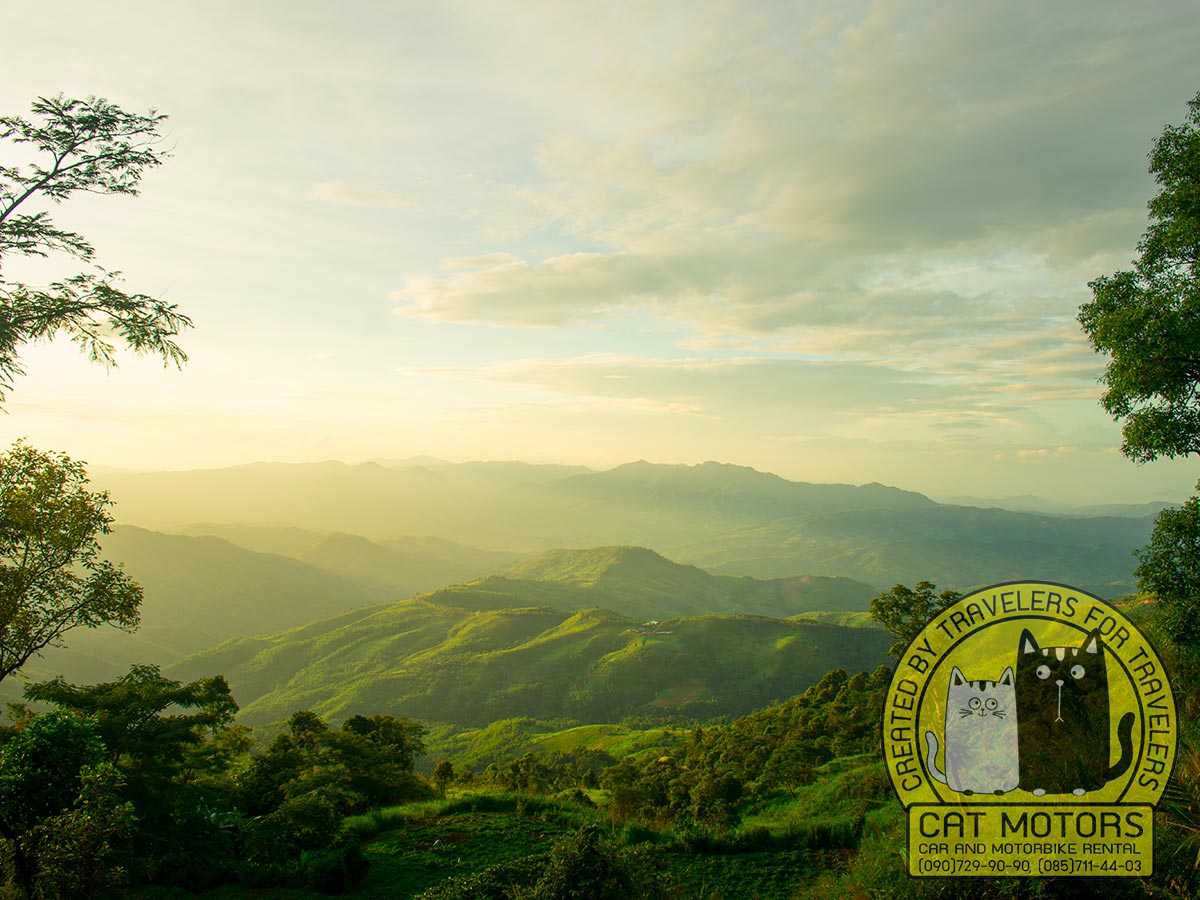
Doi Tung (Mae Fah Luang), part of the Nang Non-Mountains is, in fact, the highest peak of this mountain range that is heavily forested and about 1650 meters above sea-level. At the summit, there is a Temple, a bunch of cafes and a tree garden. The weather here is cold and icy all year around.
Our blog has a travel guide about Doi Tung! Be sure to read it if you are heading to Chiang Rai!
View Point
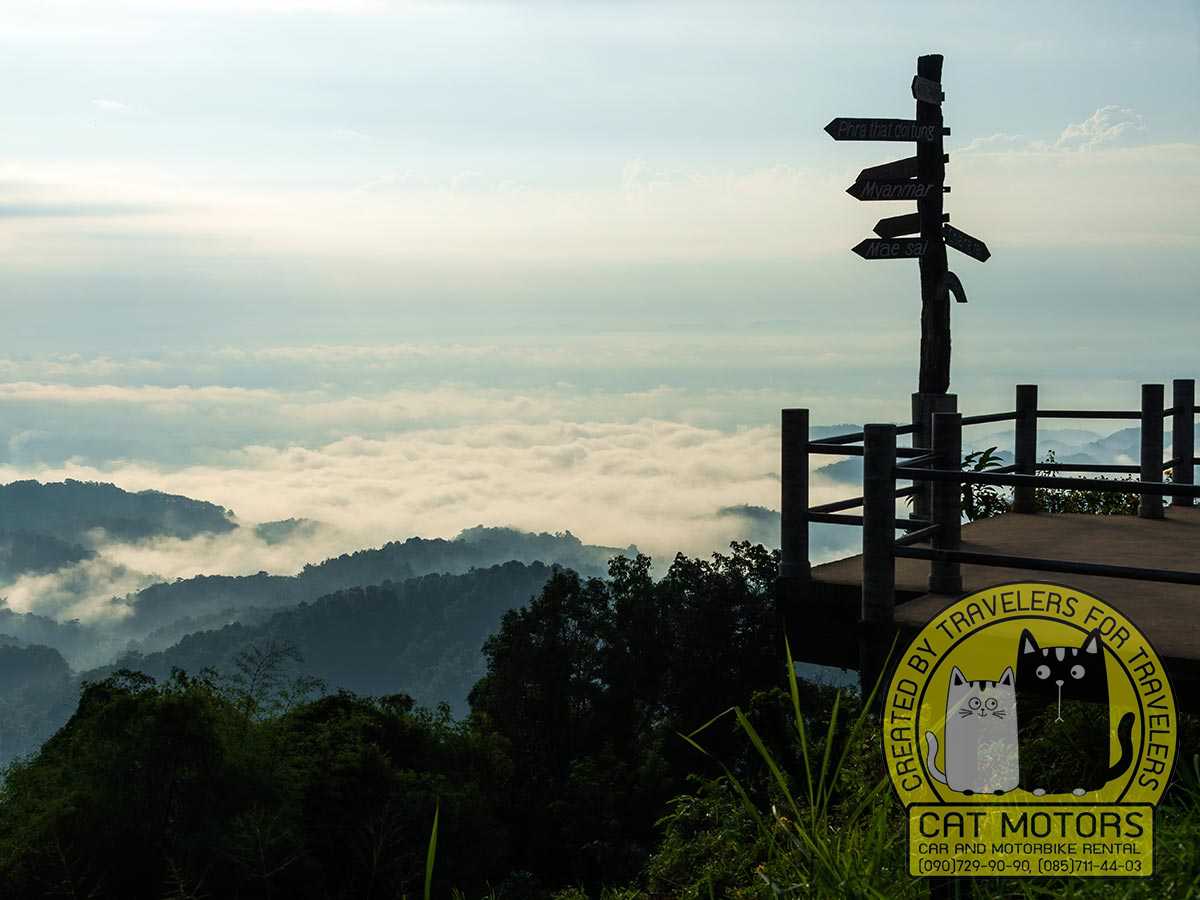
As with every summit, Doi Tung too has a designated viewpoint that offers a panoramic view of the entire mountain range and a beautiful village – that is also the best place to see the sunrise and sunset. There are many trails in and around the summit that every nature lover will enjoy.
Royal Villa
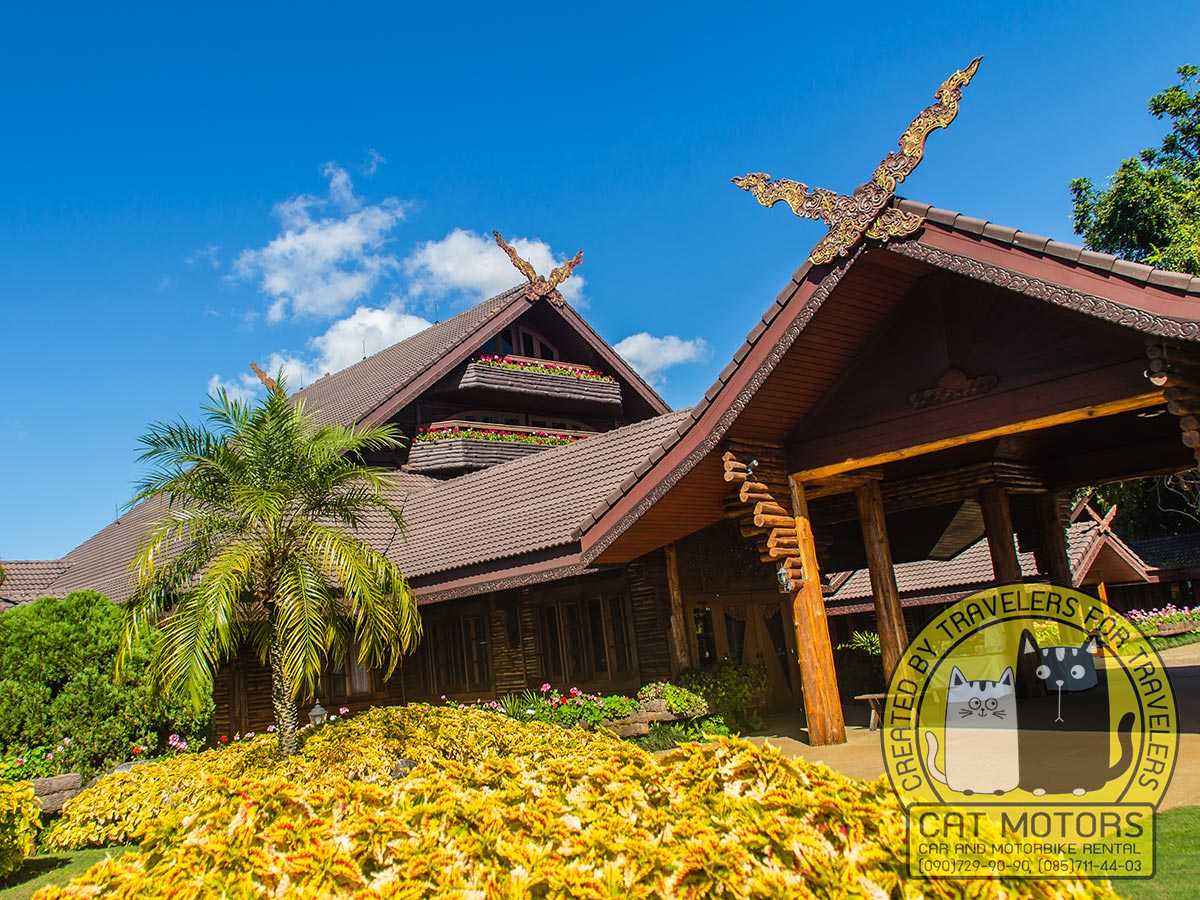
The Royal Villa is the home of Her Royal Highness the Princess Mother of Thailand. It is built in an authentic Swiss Chalet style with lawns and gardens around tastefully manicured and set up. The Royal Villa is a mixture of all that Thailand has to offer. Architecture, nature with a tinge of foreign influence.
Open from 7am-11:30am and 12:30pm-5:30pm
Entrance fee:
– for adults 90THB;
– for children 45THB
The Hall of Inspiration
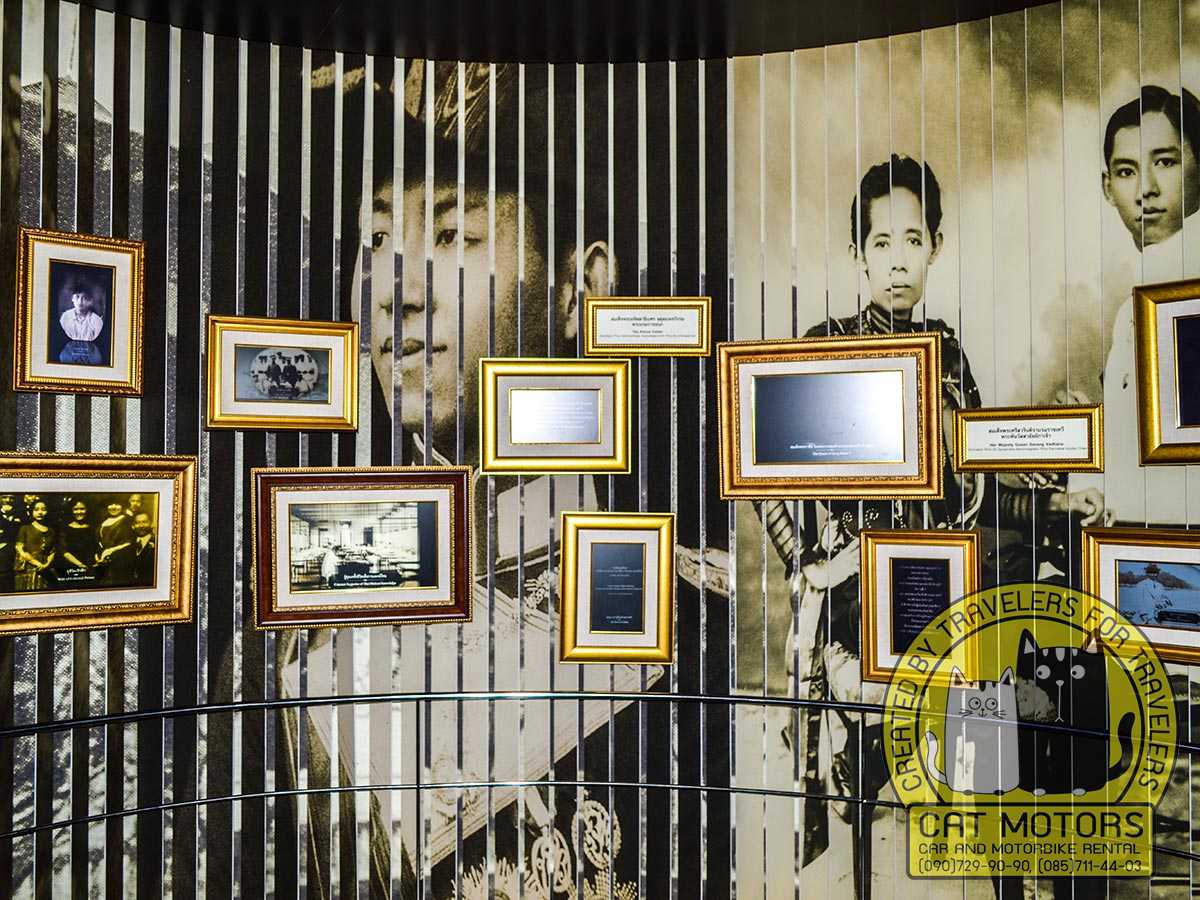
The Hall of Inspiration is a collection of stories about an old Royal Thai family called the Mahidol’s. It includes a lot of stories that depict how the family was encouraged to serve the country that also covers three generations of the family. Each of the exhibits posing as an encouragement to serve Thailand.
Open from 8am-5pm.
Entrance is free.
Botanical Garden

Home to all sorts of flora and fauna, the Doi Tung Botanical Garden is a nice place to kick back, relax, read a book and just cool off. The main features of the garden are the shaped walks and sculpted hedges that pose as a great place to take pictures.
Open from 6:30am-6pm.
Entrance fee:
– for adults 90THB;
– for children 45THB
Doi Tung Tree Top Walk
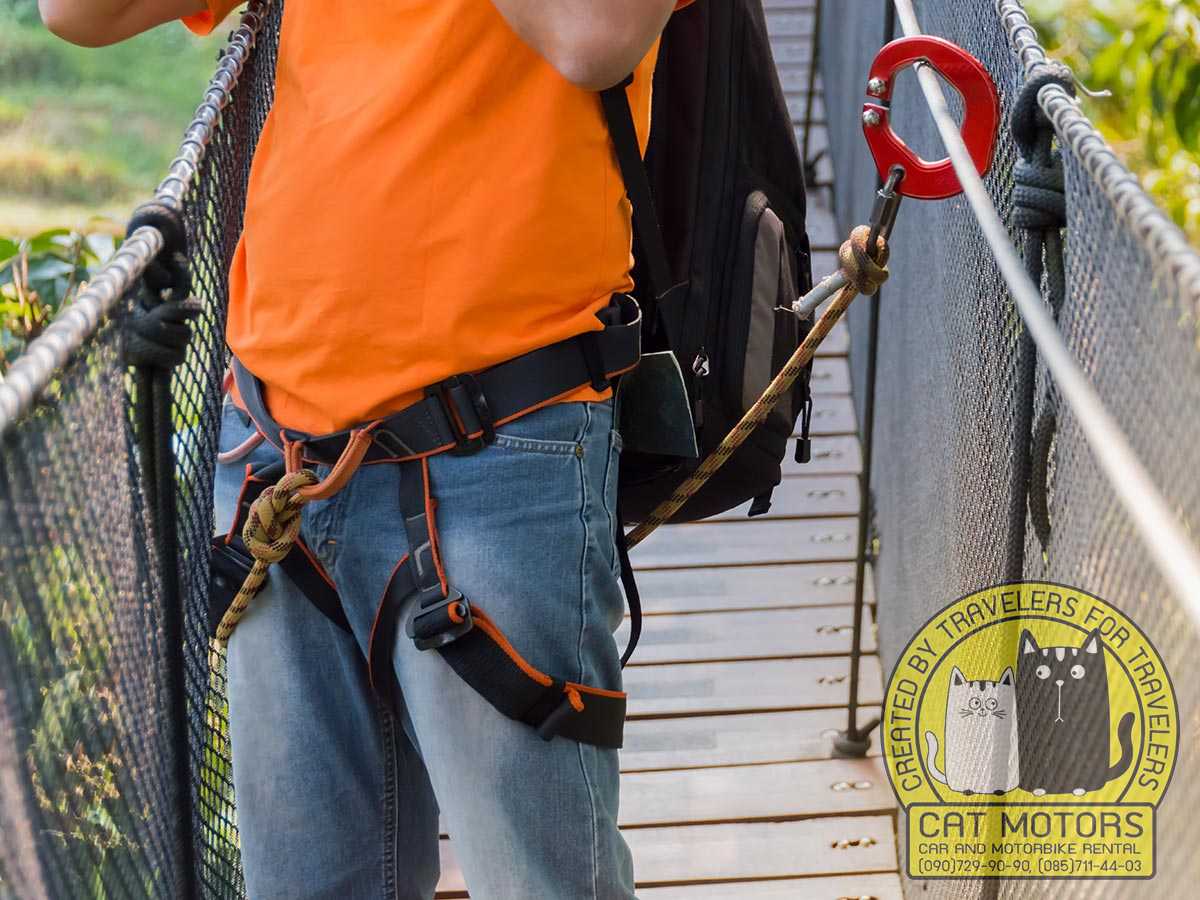
The Doi Tung Tree Top Walk is a remarkable experience located amongst the Botanical Gardens where tourists walk along a 300 meter wooden rope bridge. After being harnessed into a safety belt, you can then walk across the treetops and have a beautiful view of the Gardens below and the mountain range above.
Entrance fee:
– for adults 200THB;
– and children 100THB
Doi Tung Temple + viewpoint
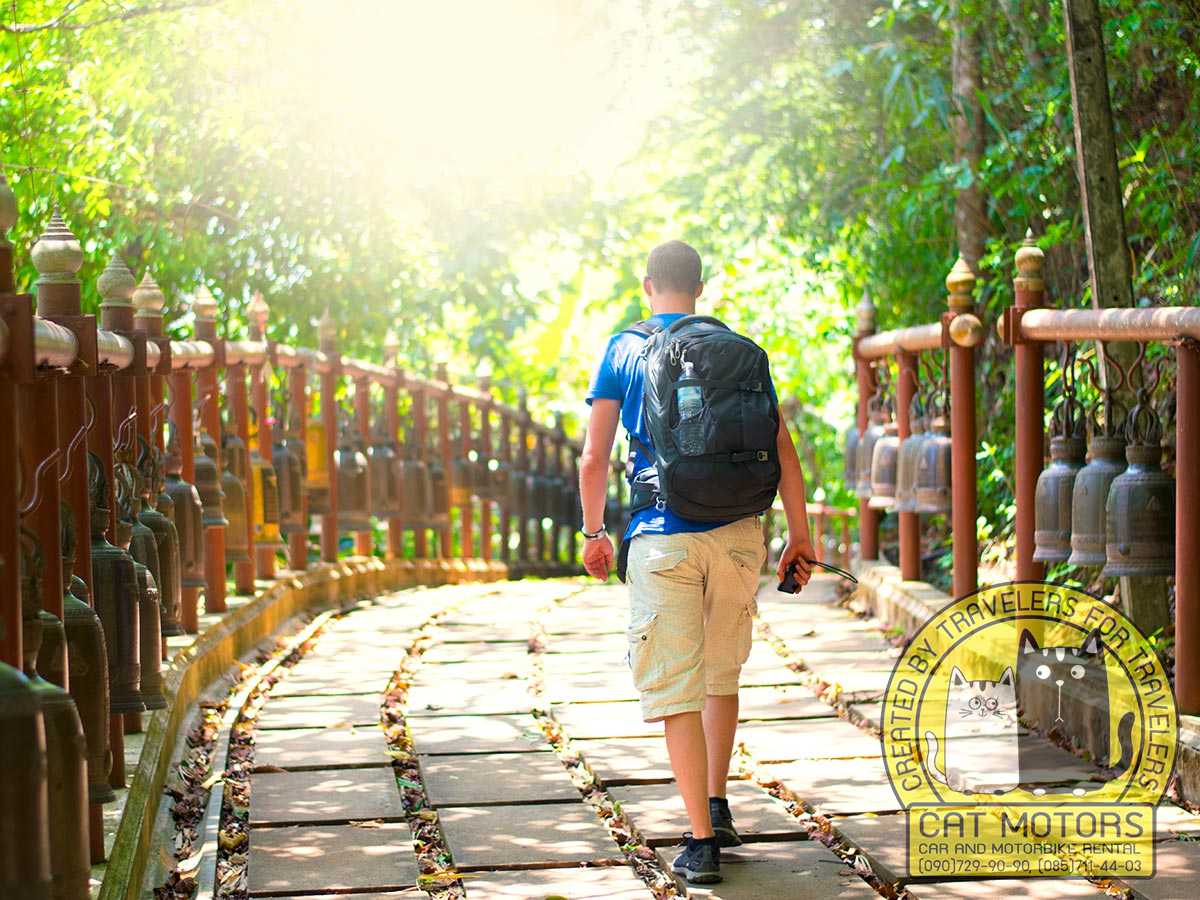
Near the summit of Doi Tung, is the Doi Tung Temple called Wat Phra That Doi Tung. The site is at about 2,000 meters above sea-level and was built in the 10th Century. The Temple atop Doi Tung has twin stupas, both stupas being golden in color. The site is in a quaint little location that offers a nice panoramic view of the mountain range and if you’re really lucky, you get to see the clouds above.
To the left of the main building is a path that leads to the amazing viewpoint.
In this place of the Chiang Rai Loop you can see the surroundings from a bird’s eye view – so remember, you are not a bird and therefore you should be careful! Take precaution and hold onto the handrails provided.
Doi Tung Arboretum
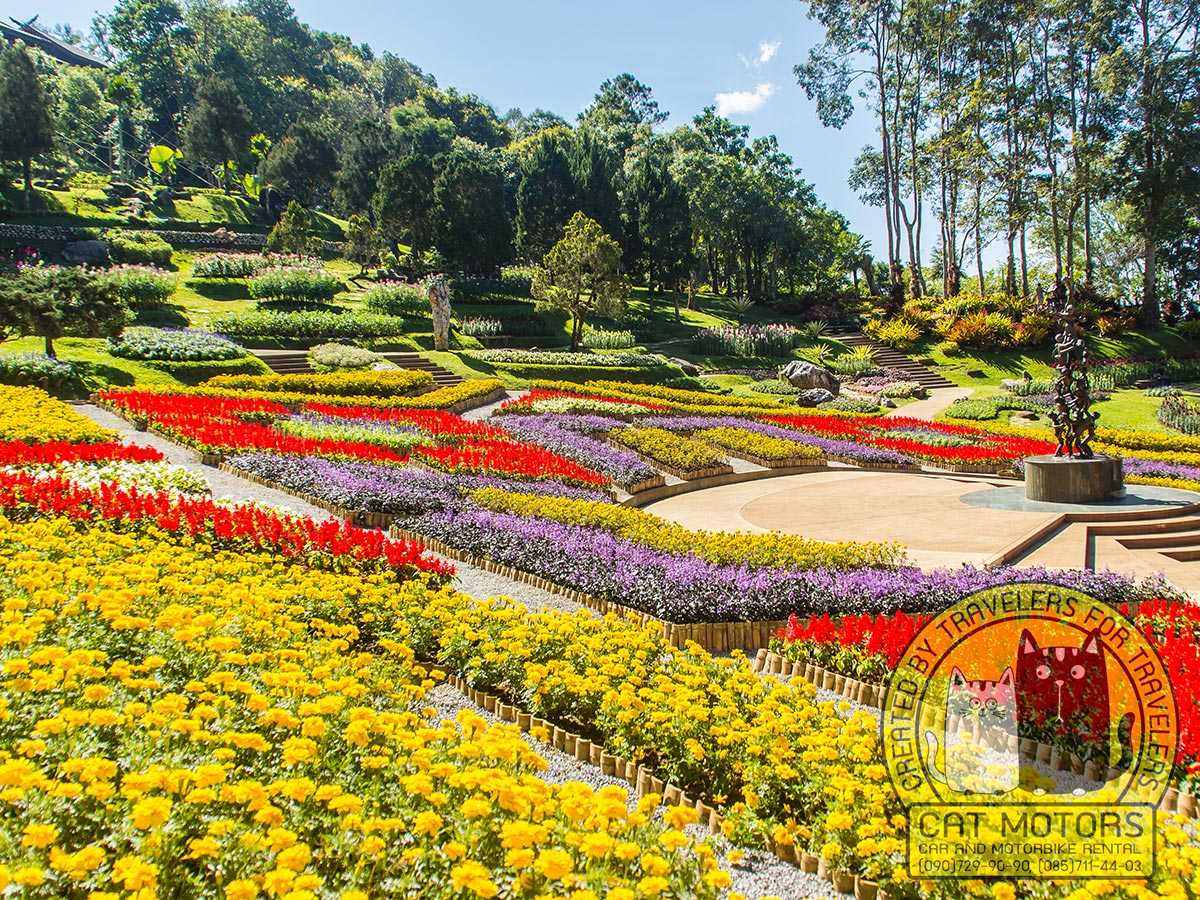
Slash and burn farming techniques destroyed large portions of the forest on Doi Tung. The Princess Mother dedicated herself to restoring a particularly damaged area which is now known as the Doi Tung Arboretum. It’s 9 kilometers north of the Doi Tung Royal Villa and is replanted with native and non-native flowers and trees. There is a walking path, too, that offers panoramic views of Thailand’s neighboring country, Burma.
Open between 7am-5:30pm.
Entrance fee:
– for adults is 90THB;
– for children 45THB
Day 3: Mae Salong – Doi Angkhang (coldest point in Thailand)
Direct route – 113km
Scenic route – 145km
Things to do on the way to Doi Ang Khang:
Tea Farm (101 Tea)
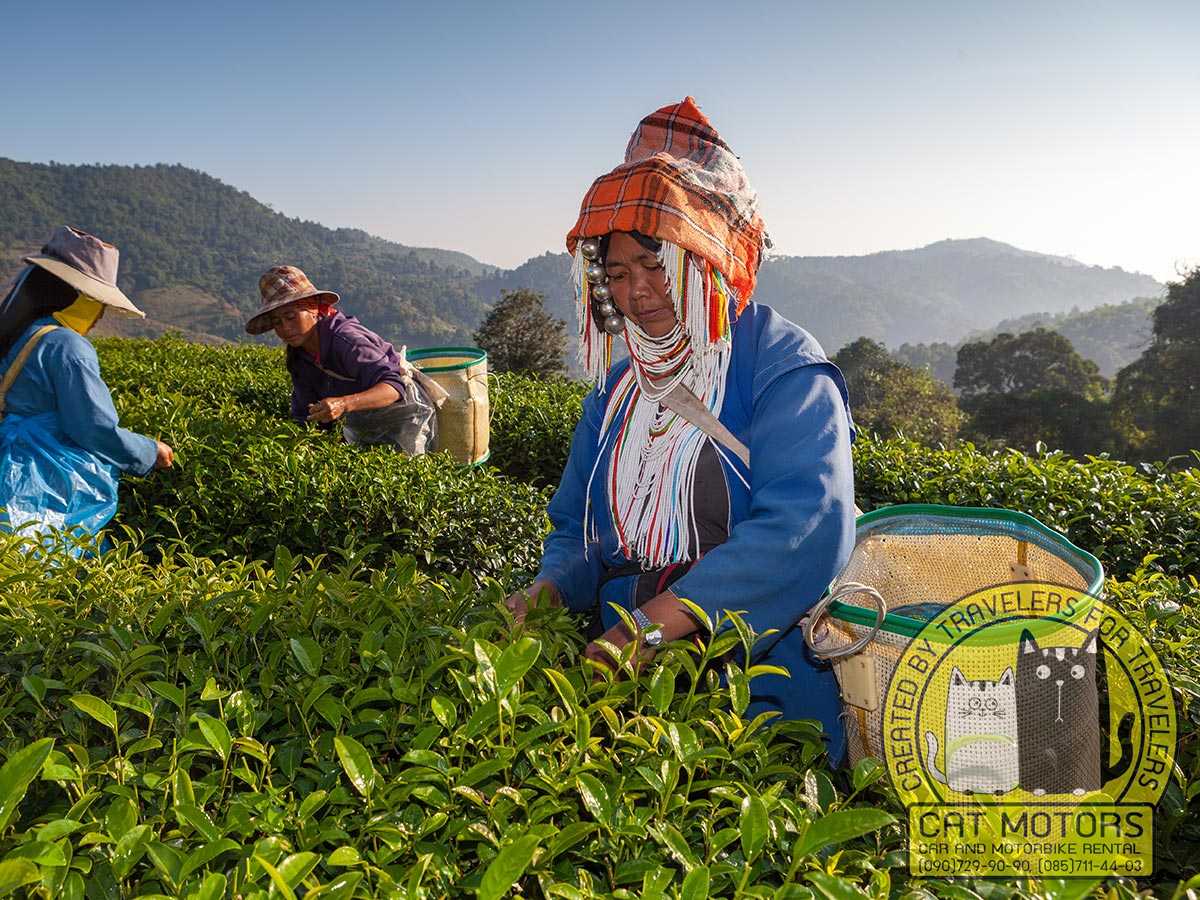
The Chiang Rai province is best known for its tea plantations, and along the route from Mae Salong to Doi Ang Khang, it is blessed with tea farms in abundance. You can stop for a bit, enjoy a fresh cup of tea with the local tea-pickers and make a photo or two while you’re at it.
Phra Boromathat Chedi
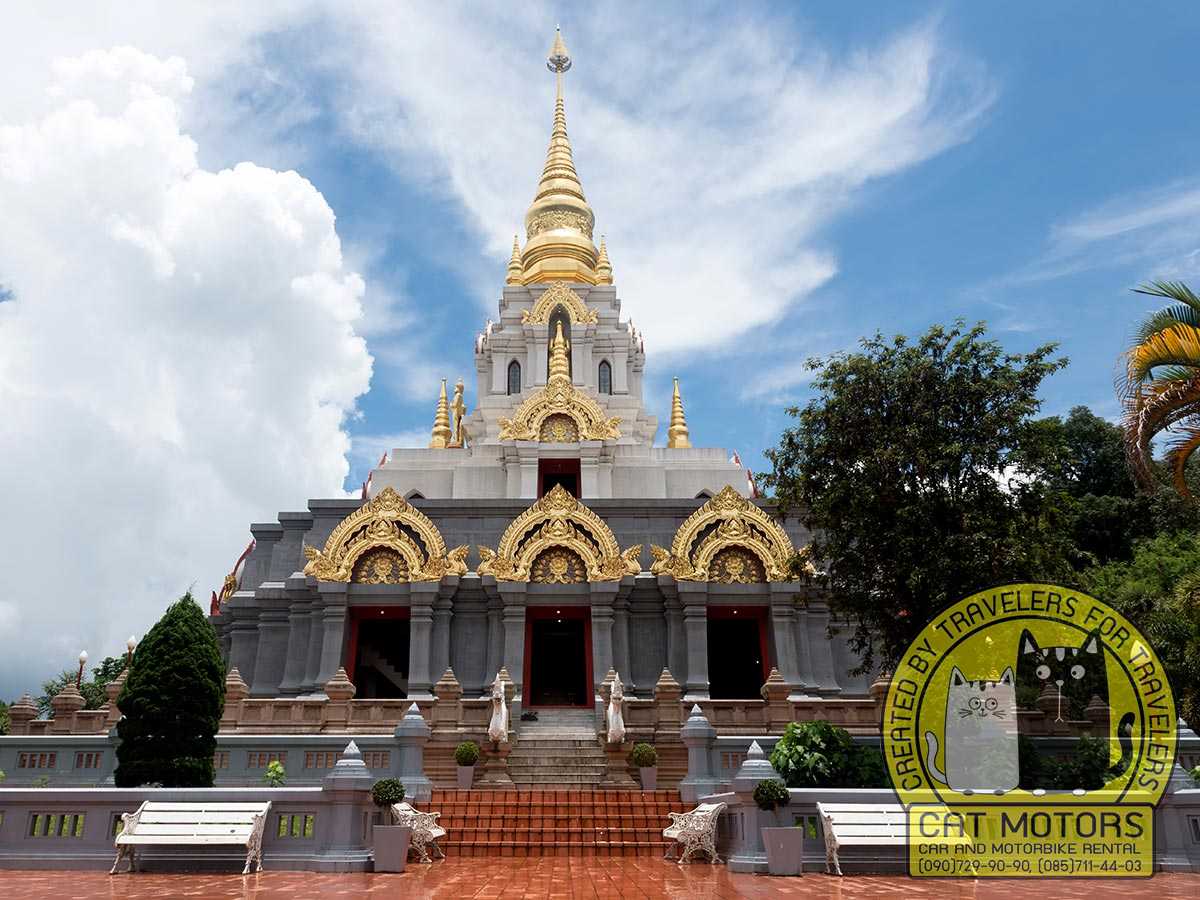
Set against a bright blue sky, the white with golden carvings stupa of Phra Borommathat Chedi is a site to take in being one of the last remaining symbols of the influence of the Srivijaya Kingdom.
It is a standing testament to the diverse history of Thailand and like most temple or monastery set-ups, the Phra Borommathat Chedi is also built on top of a hill and provides panoramic views of the towns below.
Memorial Park, General Tuan Shi-Wen tomb
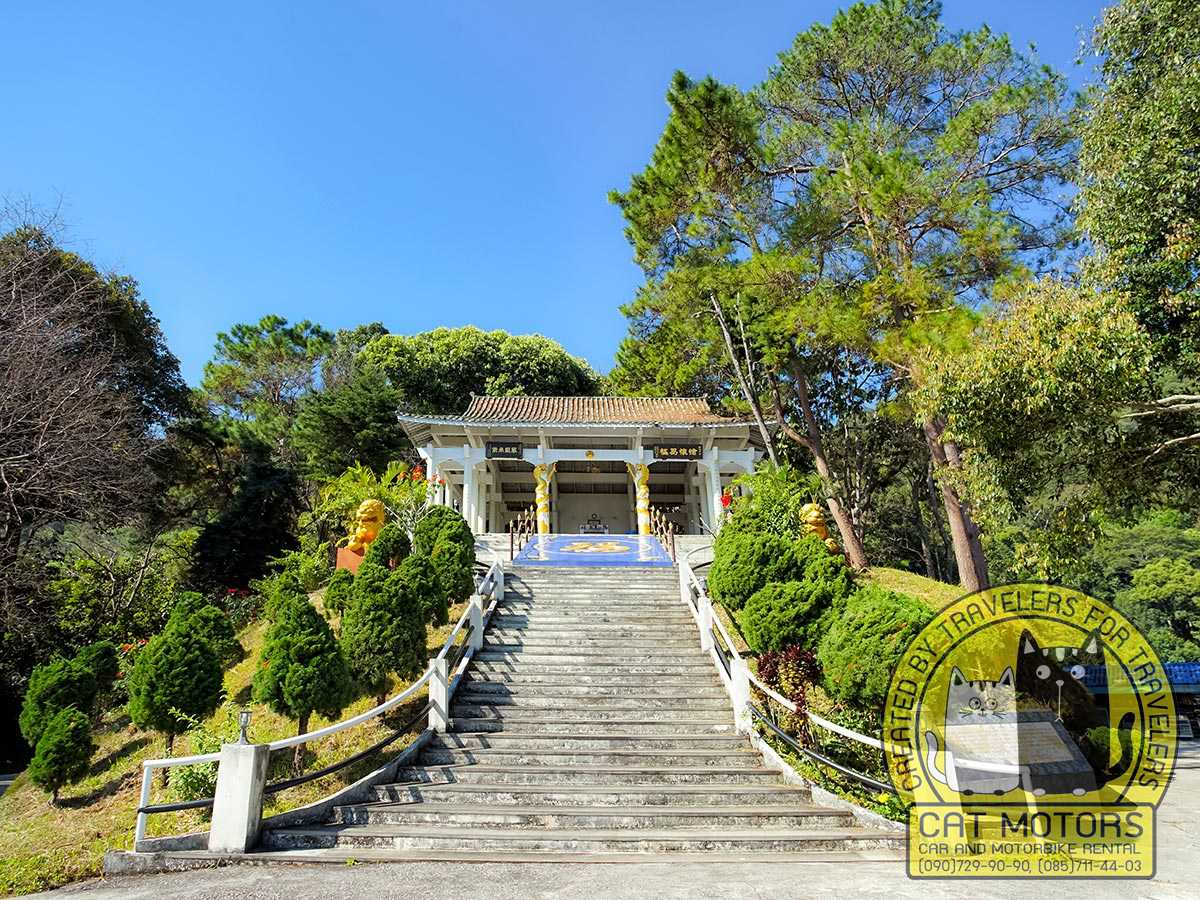
General Taun Shi-Wen is the General that led the Chinese anti-communism division forces into Thailand during the communist revolution. He made it as far as Doi Mae Salong but unfortunately died there. In his memory, there is a tomb that was erected on one of Doi Mae Salong’s many hills and it still remains.
“We have to continue to fight the evil of communism, and to fight you must have an army, and an army must have guns, and to buy guns you must have money. In these mountains, the only money is opium”
— Gen Tuan Shi-wen, Weekend Telegraph (London), 10 March 1967
Wat Thaton

The Wat Thaton is a large temple complex in Thailand that is only a few kilometers shy of Burma. The temple complex, at one point, had only the main stupa but with more tourists coming its way, a couple of supporting structures have recently been built to give the temple complex a grander look. The temple, like most temples in the region, is built on top of a hill that overlooks a couple of villages and a small river that flows down below.
Fang Hot Spring

Fang hot springs is are in the middle of a national park that have multiple little geysers that lead up to the main geyser. The area surrounding it is quite forested with the little development that the Thai Tourist Department has done but it blends in well with the surroundings.
The Fang Hot Springs is a nice little place to relax and take a dip during the winter months.
When driving to Doi Angkhang and sleeping, don’t forgot warm clothes, closed shoes, and motorbike gloves. In January, the temperature can reach minus 3 degrees Celsius (26°F) and the hotels there have no heating devices only very warm blankets.
Day 4: Doi Angkhang – Chiang Mai
Direct route – 160km
Scenic route – 173km
Doi Ang Khang viewpoint (5:00-5:30)
As with every summit, Doi Angkhang has a viewpoint too that offers a panoramic view of the entire mountain range with a beautiful view – definitely a great place to watch the sunrise and sunset.
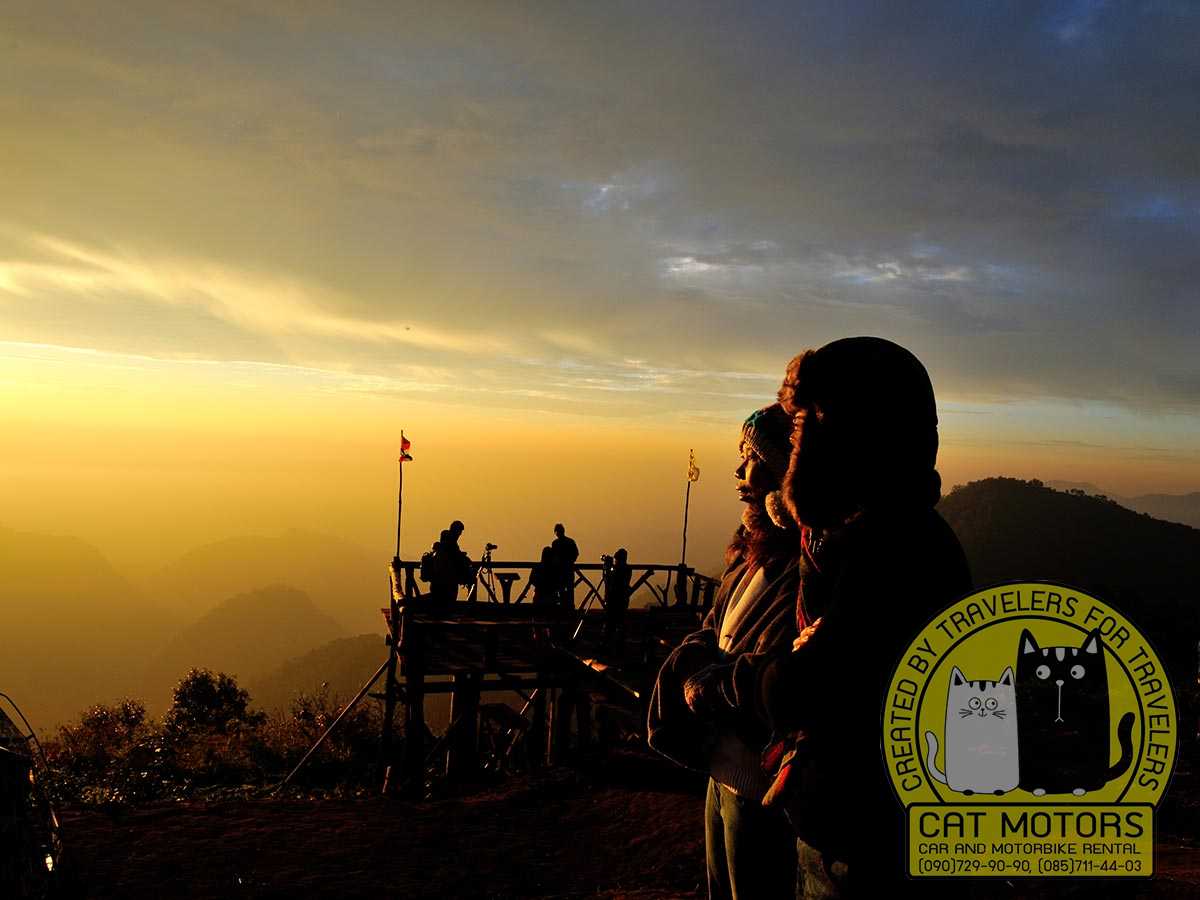
There are many trails in and around the summit that every nature lover will enjoy. Also, many tea and coffee stalls at the summit for tourists to enjoy while they take a minute in the lap of mother nature. This, however, is on the way to Chiang Mai so is usually just a stop on the way.
The coldest point on the Chiang Rai Loop. Yes, you may be cold and your nose may be blue and covered with light frost, but you are still in Thailand! Be sure to check out our detailed guide to Doi Ang Khang before visiting this place.
If you return from Doi Ang Khang to Chiang Mai on the road passing through Chiang Dao, you can visit Hinoki Land.
Chiang Dao Cave
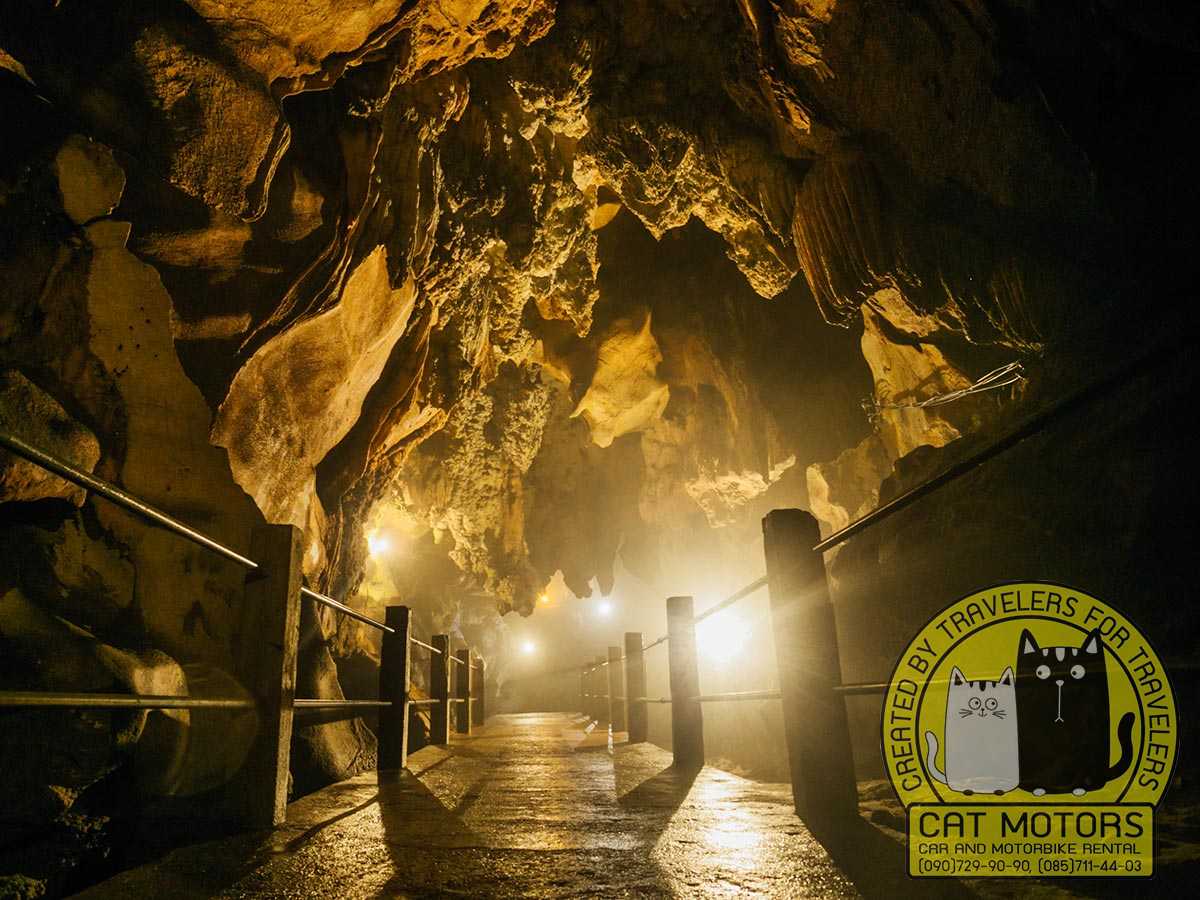
The Chiang Dao mountain has multiple caves within it that are said to be about 12 kms in length. A few of the caves are open to visitors and have well-lit ceilings and corridors that highlight the stalactites and stalagmite formations. With most of the cave being inaccessible, the parts that are accessible are led my local tour guides.
The highlight of the entire cave experience is the reclining Buddha statue inside it, but along the way, there are a lot of inscriptions and drawings on the walls that date back to centuries before. Thailand has always been known for its caves and this particular one was used as a safe-haven during the Burmese invasion and is home to a lot of history.
The entrance of the cave is about 180 steps from the car park, to which tourists have to climb the Naga Serpent staircase to enter. There is no need to worry about having to crouch down to get through the cave as the cave is quite big on its own, however, make sure that the path you take is well lit and check with the guides before wandering off into any tall caverns.
After visiting the Chiang Dao cave, you can return to Chiang Mai, or turn to road 1095 towards Pai town, and continue your journey by motorcycle for another 3-5 days on the Mae Hon Son Loop.
Wat Mae Kaet Noi (Temple of Hell)
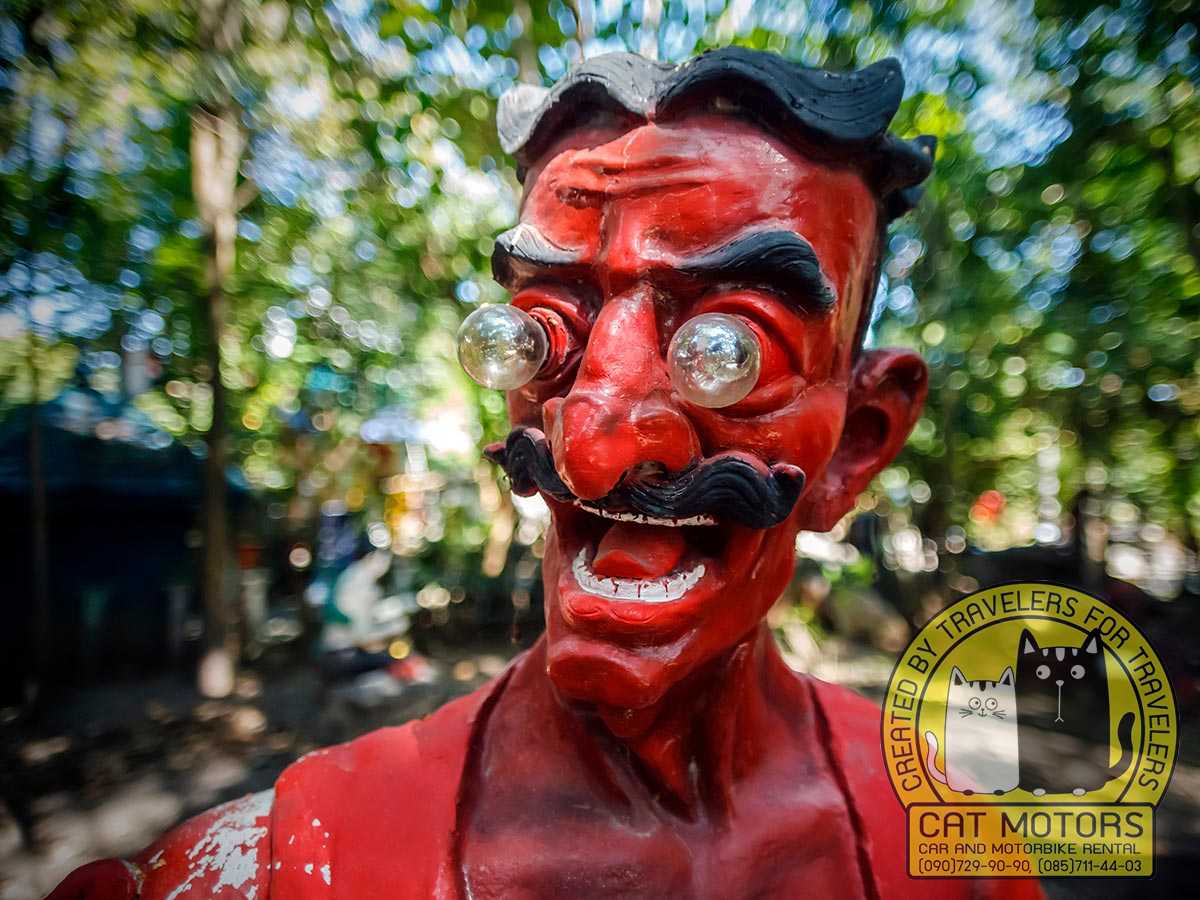
Wat Mae Kaet Noi roughly translates to Temple of Hell. The temple essentially depicts the consequences of the choices we make and show you that every choice we make determines whether we go to hell or heaven. There are a lot of interactive action machines inside this temple, so make sure you take change.
Before you visit this place – change 100-150 baht for 10 baht coins to be used on the action machines.
Weather Forecast
Quick Facts About Chiang Rai
- Basic Information about Chiang Rai:
- Location: Northern Thailand, bordering Laos and Myanmar.
- Status: Capital city of Chiang Rai Province.
- Population: Approximately 200,000 (as of latest available data).
- History: Founded in 1262 by King Mangrai, historically part of the Lanna Kingdom.
- Geography and Climate:
- Topography: Mountainous terrain, part of the larger Golden Triangle area.
- Climate: Tropical savanna climate, with distinct wet and dry seasons.
- Economy:
- Major Industries: Tourism, agriculture (particularly rice and tea), and handicrafts.
- Key Businesses: Local markets such as the Night Bazaar, major shopping centers like Central Plaza Chiang Rai.
- Culture and Society:
- Languages: Primarily Thai; Northern Thai (Lanna) and various hill tribe languages also spoken.
- Religion: Predominantly Buddhism; numerous Buddhist temples like Wat Rong Khun (White Temple).
- Traditions and Festivals: Loy Krathong (Yi Peng), Songkran festival, Chiang Rai Flower Festival.
- Tourism and Attractions:
- Notable Places: Wat Rong Khun (White Temple), Wat Phra Kaew, Black House Museum, Doi Tung Royal Villa.
- Events and Festivals: Chiang Rai ASEAN Flower Festival, Chiang Rai International Balloon Fiesta.
- Transportation:
- Modes of Transport: Mae Fah Luang-Chiang Rai International Airport, bus services, tuk-tuks, rental cars.
- Road Network: Major roads include Phaholyothin Road; connects to Chiang Mai via Route 118.
- Education and Science:
- Educational Institutions: Mae Fah Luang University, Chiang Rai Rajabhat University.
- Research Institutes: Various research centers at Mae Fah Luang University.
- Healthcare:
- Medical Facilities: Overlook Chiang Rai Hospital, Kasemrad Sriburin General Hospital.
- Sports and Recreation:
- Sports Facilities: 700th Anniversary Stadium, various local sports clubs.
- Entertainment: Chiang Rai Night Bazaar, walking streets, local theaters.
- Connections with Other Cities and Regions:
- Sister Cities: Tottori, Japan; Kunming, China.
- Trade and Cultural Links: Strong connections with other cities in the Greater Mekong Subregion.
Video Review
9 Amazing Things to See and Do
By the way, there is no mention of Wat Huay Pla Kang in our travel guide, which you can see in the preview for this video. This landmark, which includes a giant Guanyin statue and a 9-story chedi, is described in a separate landmark review. If you need more information about this place, read our detailed article about Wat Huay Pla Kang. It is recommended to visit this place in the afternoon to enjoy not only the daytime views of the surroundings but also the delightful views of this place at night when the lighting of the structures and scenery is turned on.
Blown Away in Chiang Rai Province
Chiang Rai Day Trip
FAQ
The easiest way to get to Chiang Rai is by plane. There are direct flights from Bangkok to Chiang Rai International Airport. You can also take a bus from Bangkok to Chiang Rai, but the journey takes much longer.
You can also take the train to Chiang Mai and then take a bus to Chiang Rai. The bus station is 5 minutes away from the train station.
If you prefer to travel by private car, then we recommend that you use the EconomyBookings and RentalCars websites to find the best car rental rates among all the major Chiang Mai rentals. You can also use a private shuttle service.
Absolutely! Chiang Rai is a beautiful city with plenty of attractions and activities to explore. From its stunning temples and lush nature to its vibrant nightlife and delicious cuisine, Chiang Rai is a great destination for travelers of all kinds.
Chiang Rai is known for its natural beauty, including mountains, waterfalls, and caves. It is also known for its vibrant night markets, traditional temples, and hill tribe villages. Additionally, Chiang Rai is home to the famous White Temple (Wat Rong Khun) and the Golden Triangle, where the borders of Thailand, Laos, and Myanmar meet.
No, Chiang Rai is not in Bangkok. Chiang Rai is located in northern Thailand, while Bangkok is located in the south-central region. The two cities are about 745 km (464 miles) apart.
No, Chiang Rai and Chiang Mai are two different cities. Chiang Rai is located in northern Thailand, while Chiang Mai is located in the north-central region. They are both popular tourist destinations, but they have different attractions and cultures.
Yes, you can fly to Chiang Rai. There are direct flights from Bangkok to Chiang Rai International Airport (CEI). You can also take a bus or train from Bangkok to Chiang Rai, but the journey takes much longer.
Yeap, Chiang Rai has an international airport. Chiang Rai International Airport (CEI) is located about 8 km (5 miles) from the city center. The airport offers direct flights to Bangkok, as well as other cities in Thailand and Southeast Asia.
The amount of time to spend in Chiang Rai depends on your interests and the activities you plan to do. Generally, two to three days is enough to explore the city and its attractions. However, if you plan to visit the hill tribe villages or take a day trip to the Golden Triangle, you may want to stay longer.
Yes, Chiang Rai is a very walkable city. The city center is compact and easy to navigate on foot. There are plenty of sidewalks and pedestrian crossings, and the streets are generally well-maintained. The city also has a good public transportation system, making it easy to get around.
The cost of living in Chiang Rai is relatively low compared to other cities in Thailand. A single person can live comfortably on a budget of around 10,000-15,000 baht ($320-480 USD) per month. This includes rent, food, transportation, and other basic expenses.
Malaria is not a major concern in Chiang Rai. The risk of contracting malaria is low, and the city is not considered a high-risk area. However, it is still recommended to take precautions against mosquito bites, such as using insect repellent and wearing long-sleeved clothing.
Yes, there have been cases of dengue fever reported in Chiang Rai. It is important to take precautions against mosquito bites, such as using insect repellent and wearing long-sleeved clothing. It is also recommended to seek medical attention if you experience any symptoms of dengue fever.
Chiang Rai has a tropical climate, with temperatures ranging from 18-35°C (64-95°F) throughout the year. The coldest months are December and January, when temperatures can drop to around 10°C (50°F).
Chiang Rai does have a river beach. It is located on the Mae Kok River, and is a popular spot for swimming and sunbathing. The beach is also a great place to watch the sunset and enjoy the views of the surrounding mountains.
Chiang Rai has a vibrant nightlife scene, with plenty of bars, clubs, and restaurants to explore. The city is known for its live music venues, which feature a range of genres from jazz to rock.
Chiang Rai has a wide variety of restaurants to choose from. Some of the most popular restaurants include Polar Boulangerie and Patisserie, Kunda Cafe Vegan Burger Chiang Rai, Favola at Le Meridien, Heaven Burger, and Ribs&Co. For a more upscale dining experience, try the restaurants at the Anantara Golden Triangle Elephant Camp & Resort.
Our travel guides open the door to Northern Thailand’s most beautiful routes and hidden gems. To get started, explore our motorbike hire in Chiang Mai home page section for top rental choices. Don’t forget to go over our rental terms to ensure a hassle-free trip. With our guides, you’ll navigate the region’s picturesque roads and vibrant communities with ease and confidence. Discover the beauty of Northern Thailand with the best preparation and resources at your disposal.
For further details on local customs, scenic spots, and riding safety, check our advice sections. These resources are tailored to provide you with practical tips and insider knowledge that will enhance your journey. Experience the true essence of Northern Thailand, fully prepared and well-informed.
Cat Motors Team
Was this post useful for you?
You can rate it by clicking on a star
Average rating / 5. Vote count:
No votes so far! Be the first to rate this post.
We are sorry that this post was not useful for you!
Let us improve this post!
Tell us how we can improve this post?
- Author: Krit Sorenser
- Updated: March 26, 2025
- No Comments


